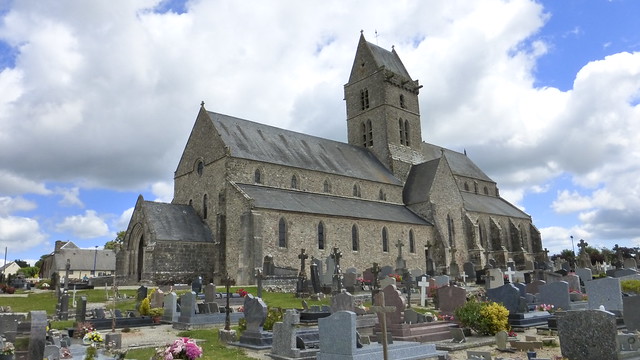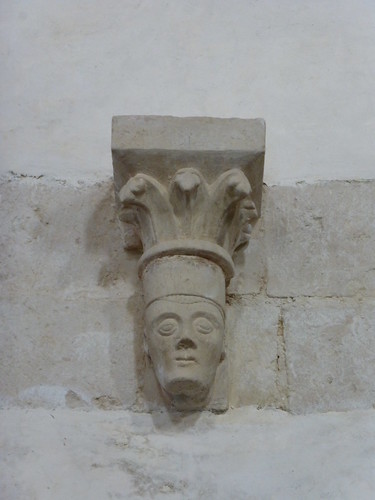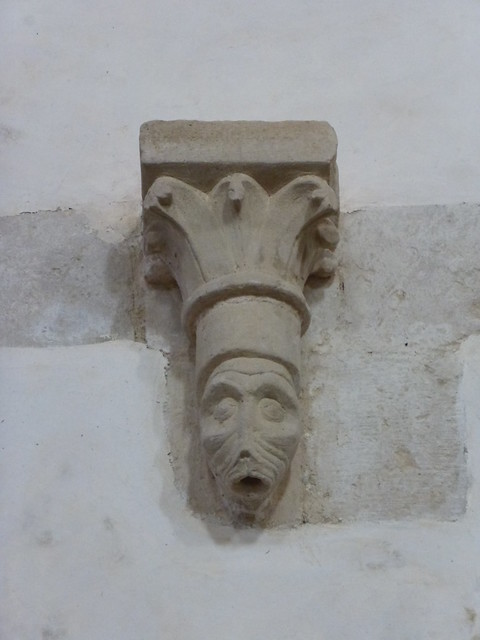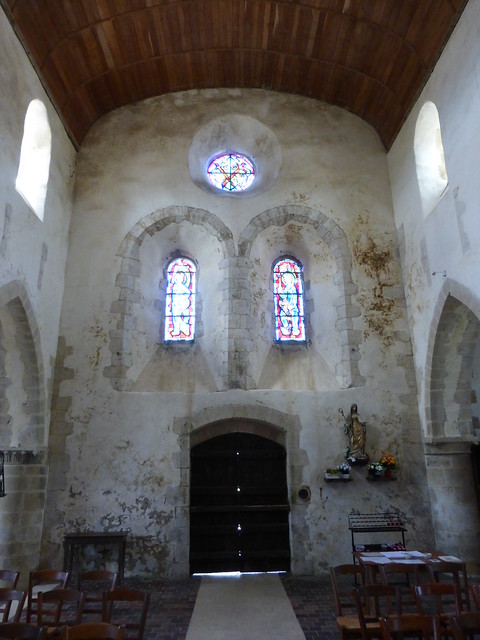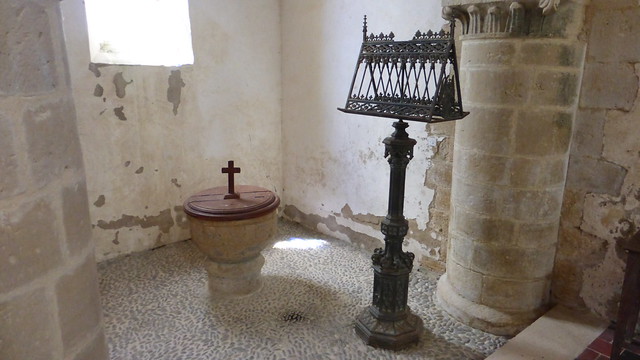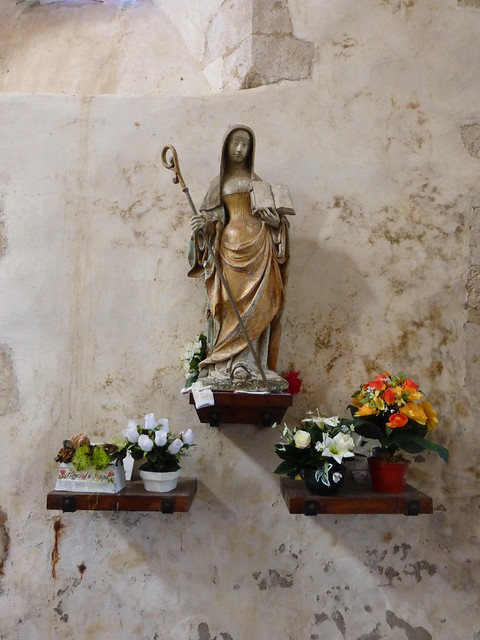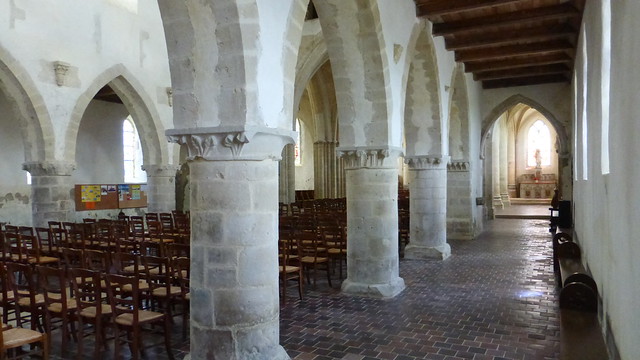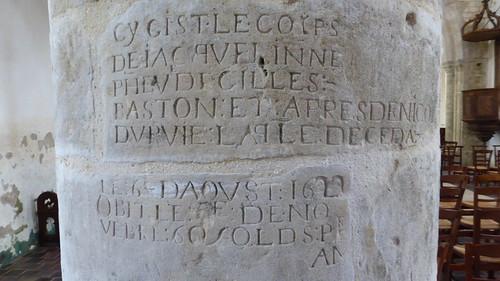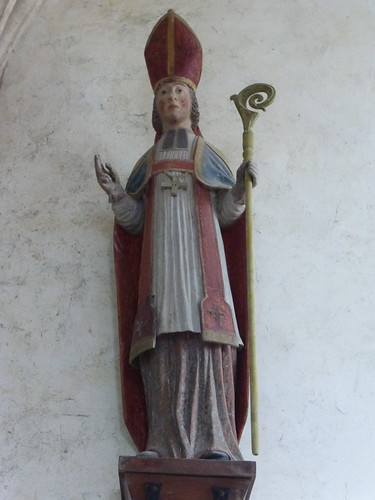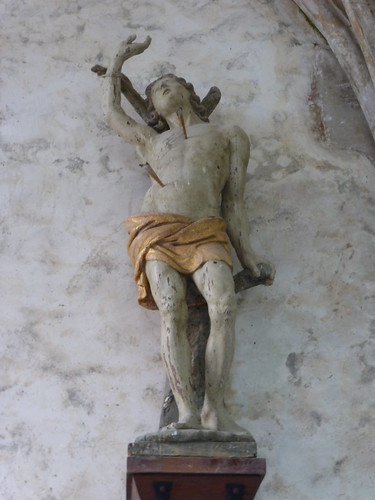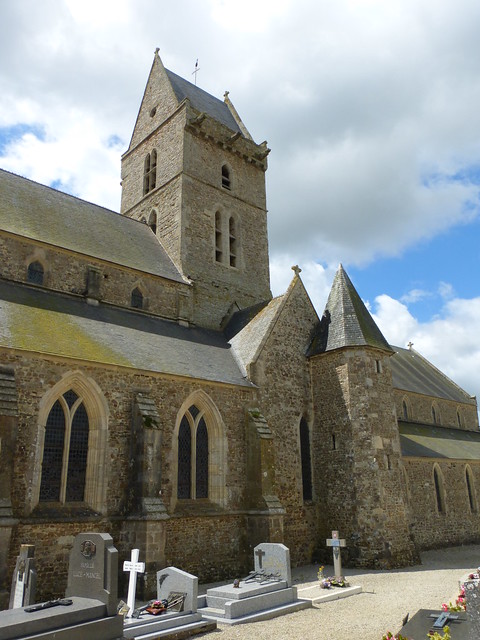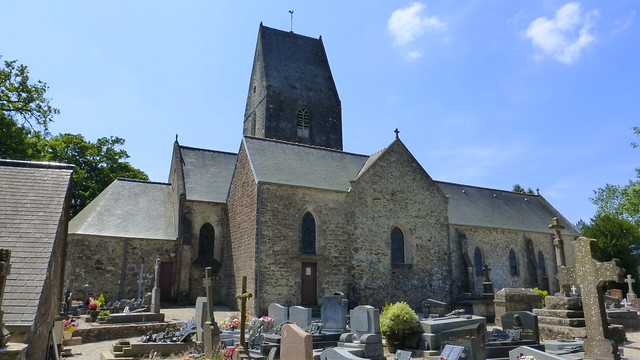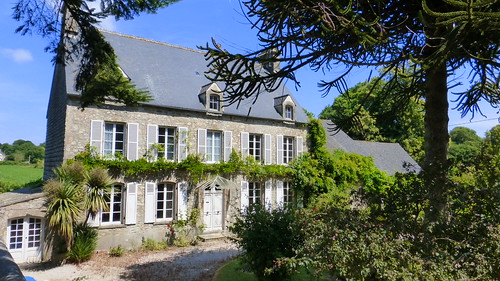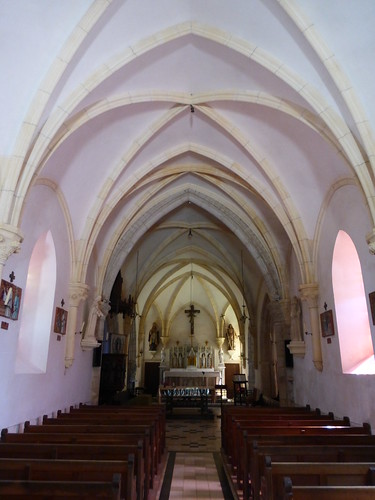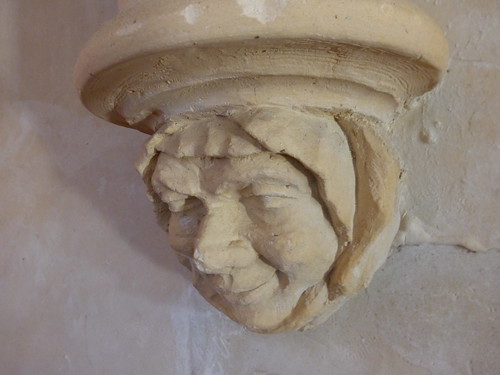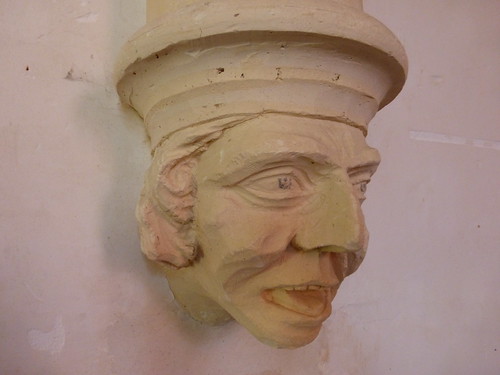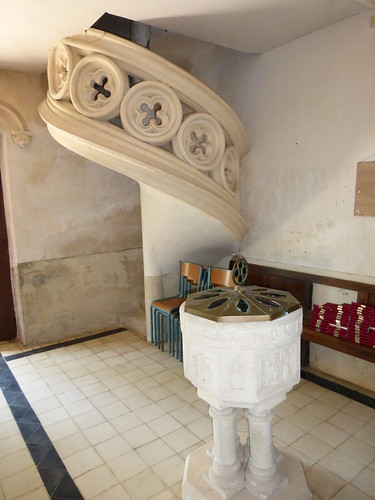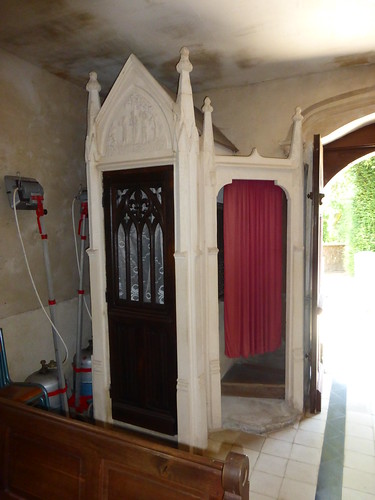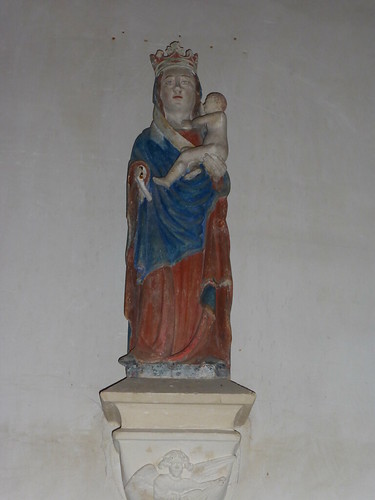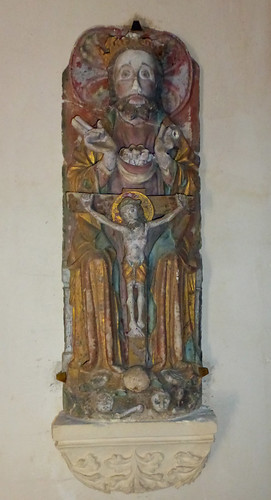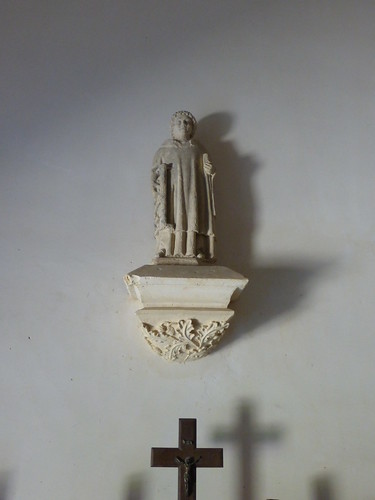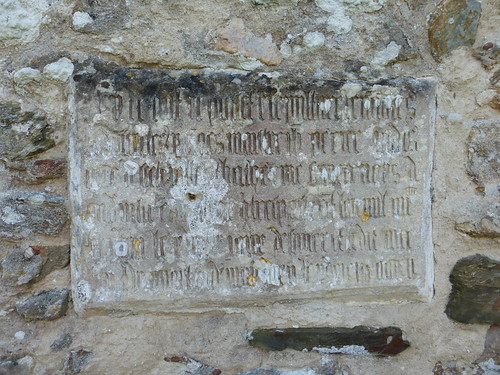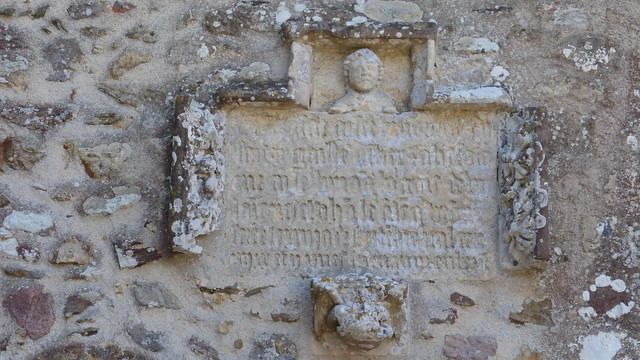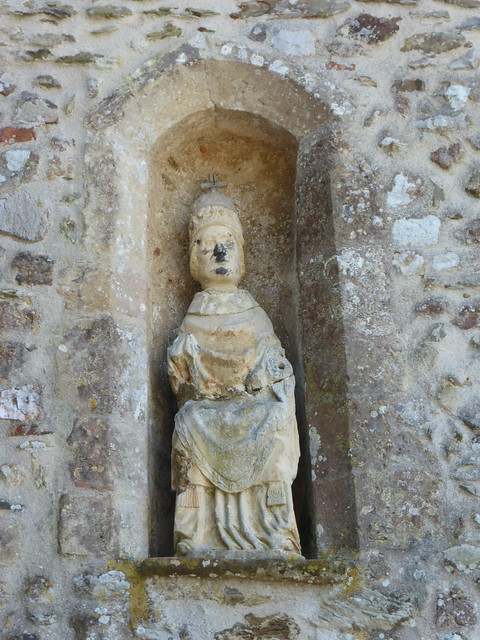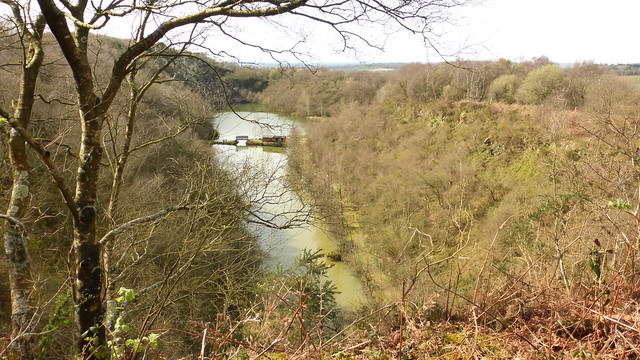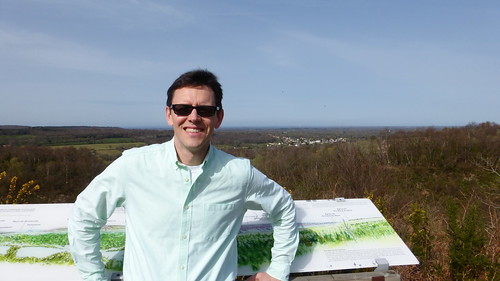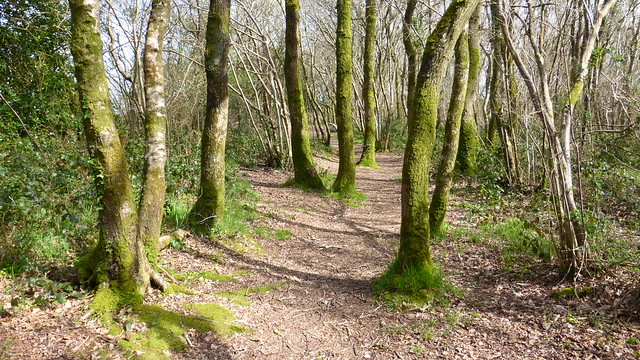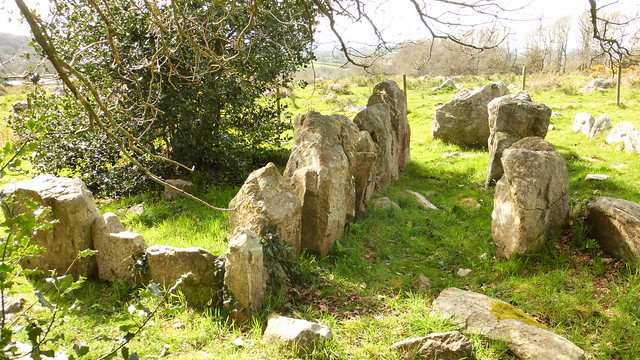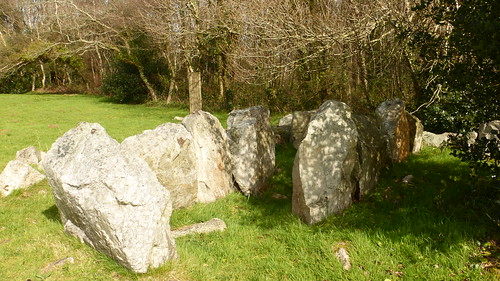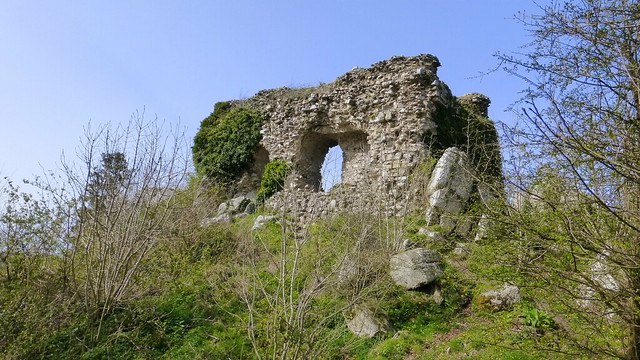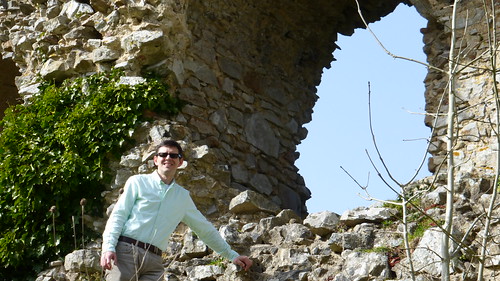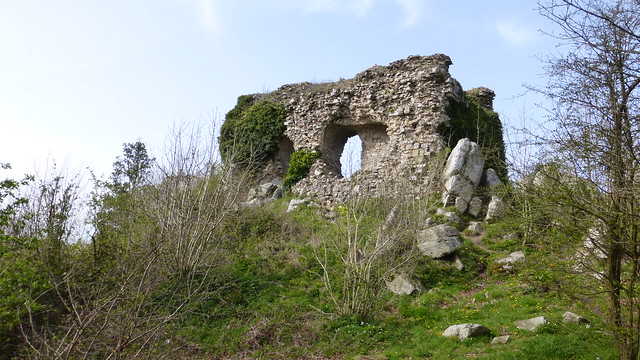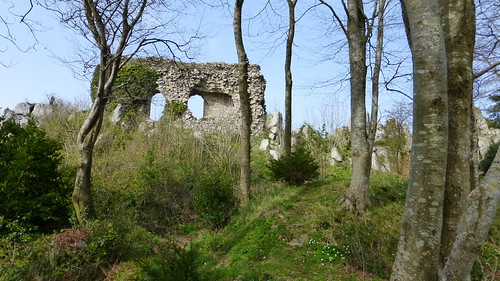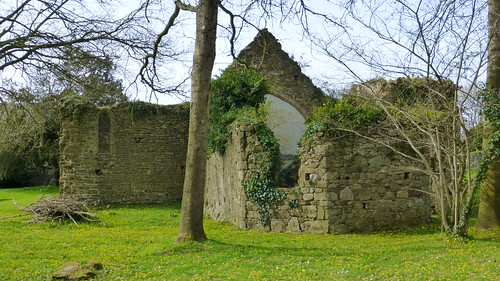July 22 2014
2
22
/07
/July
/2014
08:00
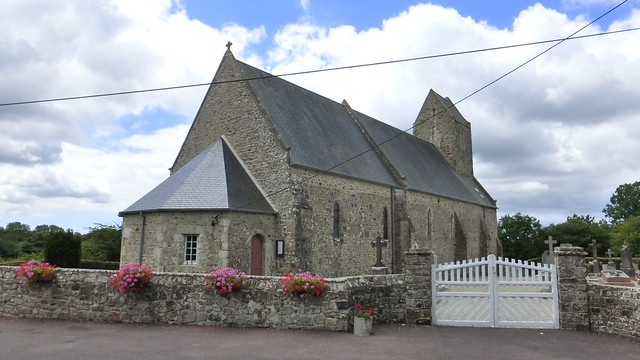
I’ve not much to say about the Église Saint-Pair in Gerville-la-Forêt except that it is from the 17th century and was closed on the day I visited. It’s the little church I came across while looking for the chapel in Vesly. The church gets its name from Saint-Paternus (or Saint-Pair) of Avranches who is said to have been born in Poitiers, become a monk at the Abbey of Marnes in France and retreated with his fellow monk, Saint Scubilion to the forest of Seicy in the diocese of Coutances before the Bishop of Coutances made him a priest in 512. The town itself is now part of Vesly but its name derives from the name of the old lords of the land, les Gervilles and the addition of la forêt which is a reference to the nearby forest of Lessay. You learn something new every day.

Published by The Baguette
-
in
Cotentin
July 19 2014
6
19
/07
/July
/2014
14:22
Published by The Baguette
-
in
Cotentin
July 13 2014
7
13
/07
/July
/2014
13:42
Published by The Baguette
-
in
Cotentin
July 13 2014
7
13
/07
/July
/2014
12:09
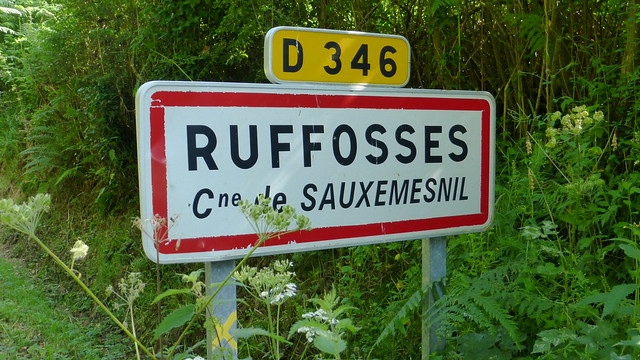
Once again, we’ve been having really nice weather in la Manche. When it’s like this, you can’t help but go outside and do something—head to the beach, ride your bike or take a nice long walk. Fortunately for me, I’ve been able to do all these things in abundance. Yesterday, I did the “Promenade et Randonnée Autour de Rochemont” which takes you through some very pretty woodlands around the village of Ruffosses, a community belonging to the small town of Saussemesnil (sometimes spelled, Sauxemesnil). 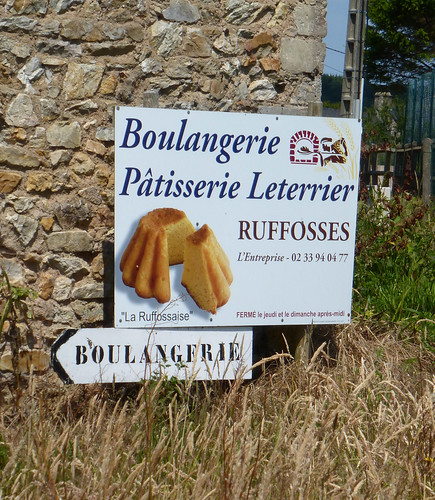
 The hike begins from a parking lot near the Boulangerie Pâtisserie Leterrier and takes you first past the Église Notre-Dame-des-Anges.
The hike begins from a parking lot near the Boulangerie Pâtisserie Leterrier and takes you first past the Église Notre-Dame-des-Anges.  There is a sign posted at the entrance that says, “By order of the mayor, the doors of this church must remain open every day.” They were closed and I was unable to go inside. An elderly man with a thick Norman accent, attending to some graves, said that it was probably too early and that it should be open later. It wasn’t. I came back after the hike and it was still locked. Oh well. As with more than a thousand churches in Normandy, the church in Ruffosses is devoted to the Virgin Mary. Before the mid-nineteenth century, the oldest religious building of Ruffosses was the Chapel of Our Lady of Deliverance which was erected by sailors in the 17th century. It was used as a place of pilgrimage for sailors until 1851, abandoned and condemned by 1853 and eventually sold.
There is a sign posted at the entrance that says, “By order of the mayor, the doors of this church must remain open every day.” They were closed and I was unable to go inside. An elderly man with a thick Norman accent, attending to some graves, said that it was probably too early and that it should be open later. It wasn’t. I came back after the hike and it was still locked. Oh well. As with more than a thousand churches in Normandy, the church in Ruffosses is devoted to the Virgin Mary. Before the mid-nineteenth century, the oldest religious building of Ruffosses was the Chapel of Our Lady of Deliverance which was erected by sailors in the 17th century. It was used as a place of pilgrimage for sailors until 1851, abandoned and condemned by 1853 and eventually sold. 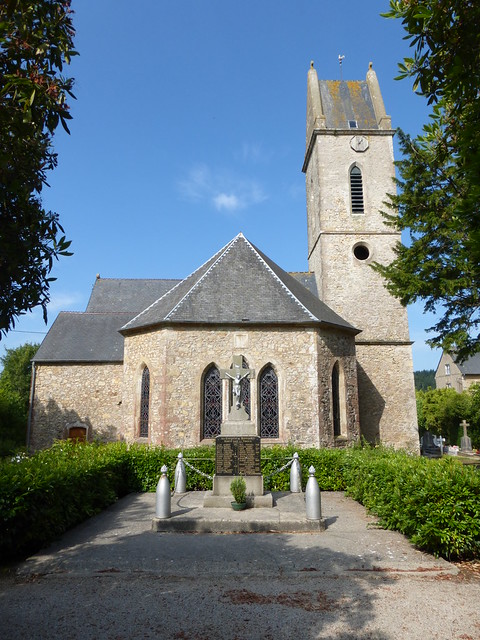 In 1854, Mme Féline de Montdésir, née Sivard de Beaulieu donated money to have a new church completed on the site. It was surrounded by a cemetery and meditation garden of exotic plants, rhododendrons and bamboo which still exist to this day. The church was bombed in 1944 and the vault collapsed in 1947 but was restored in the neo-Gothic style during the 1950s.
In 1854, Mme Féline de Montdésir, née Sivard de Beaulieu donated money to have a new church completed on the site. It was surrounded by a cemetery and meditation garden of exotic plants, rhododendrons and bamboo which still exist to this day. The church was bombed in 1944 and the vault collapsed in 1947 but was restored in the neo-Gothic style during the 1950s.  Before you leave, don’t forget to see this small chapel on the grounds devoted to Saint Anthony.
Before you leave, don’t forget to see this small chapel on the grounds devoted to Saint Anthony. 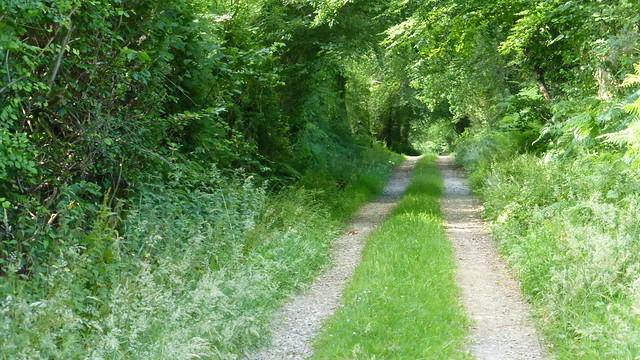 The hiking path is quite flat and very easy to follow if you keep to the marked trail which follows several small farm roads and some overgrown paths covered so thickly with trees, it appears that you’re walking through a dimly lit cave at times.
The hiking path is quite flat and very easy to follow if you keep to the marked trail which follows several small farm roads and some overgrown paths covered so thickly with trees, it appears that you’re walking through a dimly lit cave at times.  There are also several nice houses to see along the way including this one just to the left of the church.
There are also several nice houses to see along the way including this one just to the left of the church.  Along one street called la Fosse Lonlay you come across this beautiful house with a thatched roof.
Along one street called la Fosse Lonlay you come across this beautiful house with a thatched roof. 
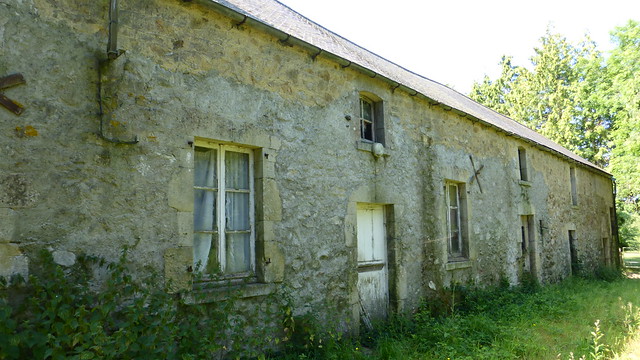 Later on, past some apple orchards you come to a place called Ferme de la Chaussée with a rundown farm which is in need of repair. I don’t think that will be a problem since most “Norman peasant” farms are being quickly bought up by the rich and turned into holiday cottages.
Later on, past some apple orchards you come to a place called Ferme de la Chaussée with a rundown farm which is in need of repair. I don’t think that will be a problem since most “Norman peasant” farms are being quickly bought up by the rich and turned into holiday cottages.  Even though this dirt road looks like any other dirt road in Normandy, it is actually the remains of the old Roman Way or Voie gallo-romaine. Le bois de l'Etot Rouge belongs to one of the most beautiful sets of woods in the Cotentin.
Even though this dirt road looks like any other dirt road in Normandy, it is actually the remains of the old Roman Way or Voie gallo-romaine. Le bois de l'Etot Rouge belongs to one of the most beautiful sets of woods in the Cotentin.  It was formerly part of the great forest of Brix, which occupied more than 7,000 hectares in the 17th century.
It was formerly part of the great forest of Brix, which occupied more than 7,000 hectares in the 17th century. 


 Along another small road called Les Planques I came across a man harvesting cherries from his trees. His house was surrounded by hydrangeas of every color. There is only one stream that you cross along the course of the hike and that takes you over the Rivire de Gloire.
Along another small road called Les Planques I came across a man harvesting cherries from his trees. His house was surrounded by hydrangeas of every color. There is only one stream that you cross along the course of the hike and that takes you over the Rivire de Gloire. 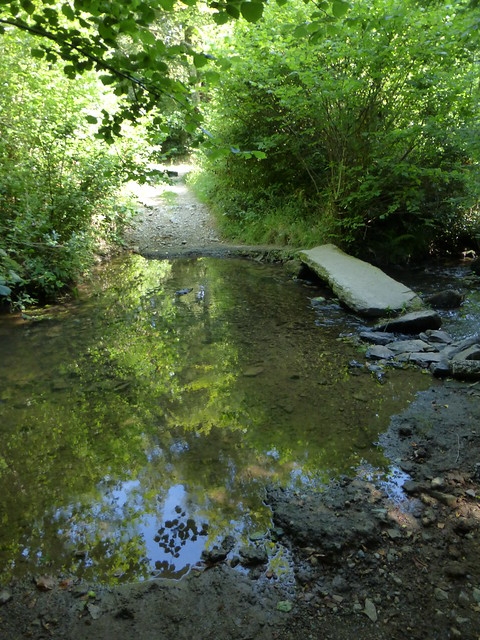
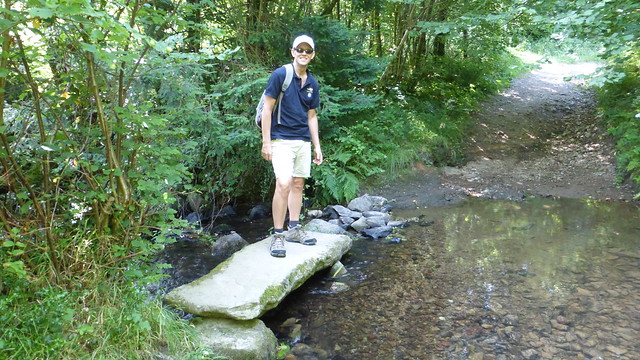 It is crossed by a ford of flat stones called Gué à pierres plates.
It is crossed by a ford of flat stones called Gué à pierres plates. 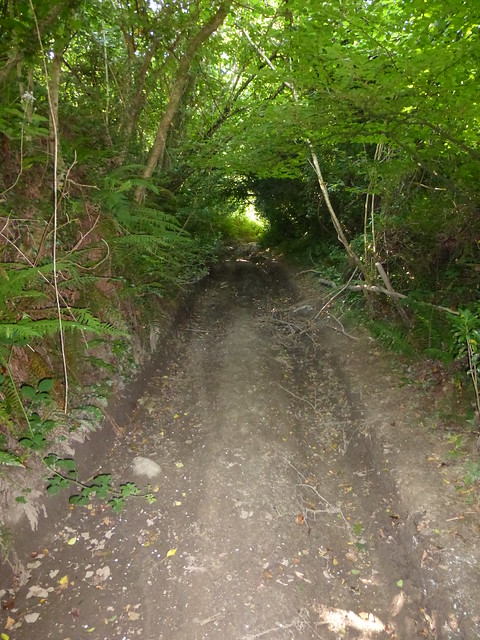

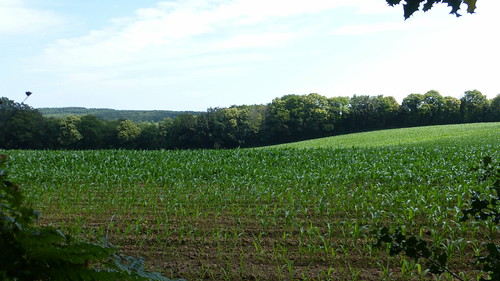
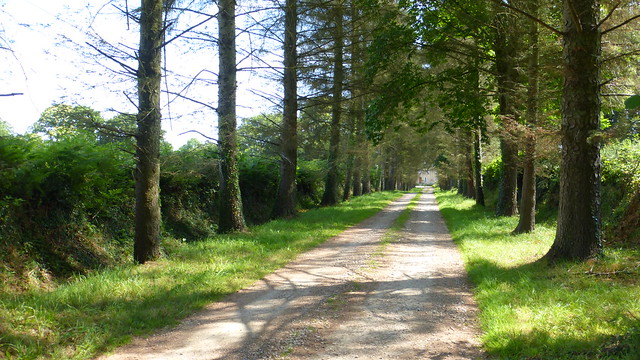
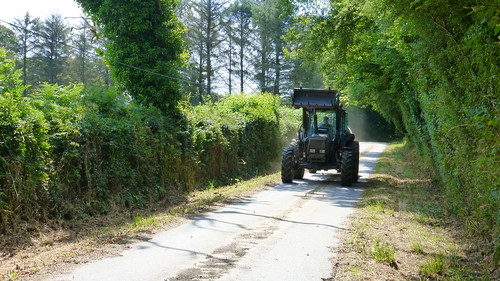 Past fields planted with corn, through country lanes lined with tall trees and through thick underbrush you'll eventually come back to this waterway again which joins les étangs de Roudoux (a series of two large ponds) within a beautiful valley.
Past fields planted with corn, through country lanes lined with tall trees and through thick underbrush you'll eventually come back to this waterway again which joins les étangs de Roudoux (a series of two large ponds) within a beautiful valley. 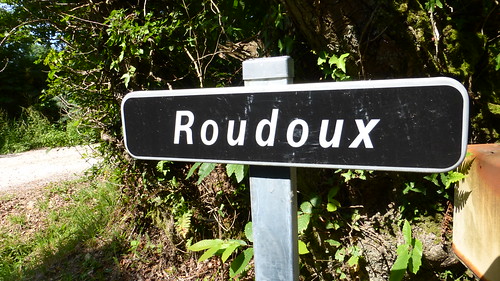
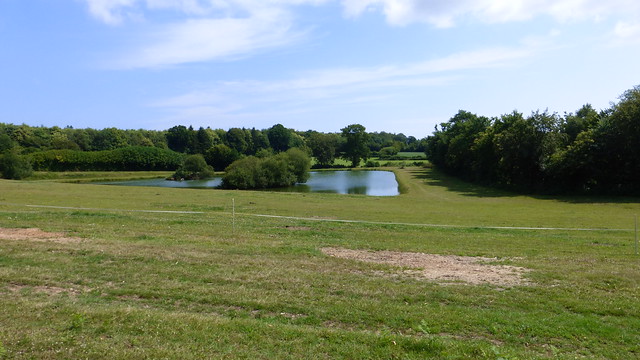
 The two ponds are located on private property and until recently they were open to visitors for water recreation activities. Unfortunately, this is no longer the case as the sign posted on the gate reads:
The two ponds are located on private property and until recently they were open to visitors for water recreation activities. Unfortunately, this is no longer the case as the sign posted on the gate reads: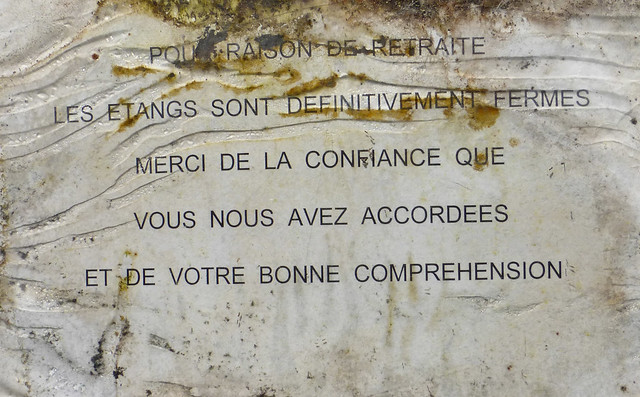

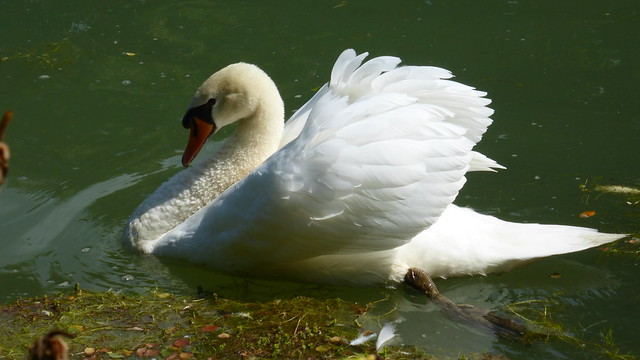 The smaller of the two lakes is still open to the public and has two large swans to entertain you. The last stretch of the hike takes you past the farm and the Château de Rochemont from whence this hike gets its name.
The smaller of the two lakes is still open to the public and has two large swans to entertain you. The last stretch of the hike takes you past the farm and the Château de Rochemont from whence this hike gets its name.  It was built in the late 18th century by ancestors of the De Mondesir family, who managed to hold onto their property despite the French Revolution due to their support for it.
It was built in the late 18th century by ancestors of the De Mondesir family, who managed to hold onto their property despite the French Revolution due to their support for it. 

 The outbuildings and nearby farm house are lined with more hydrangeas in nearly every shade of blue you can think of.
The outbuildings and nearby farm house are lined with more hydrangeas in nearly every shade of blue you can think of. 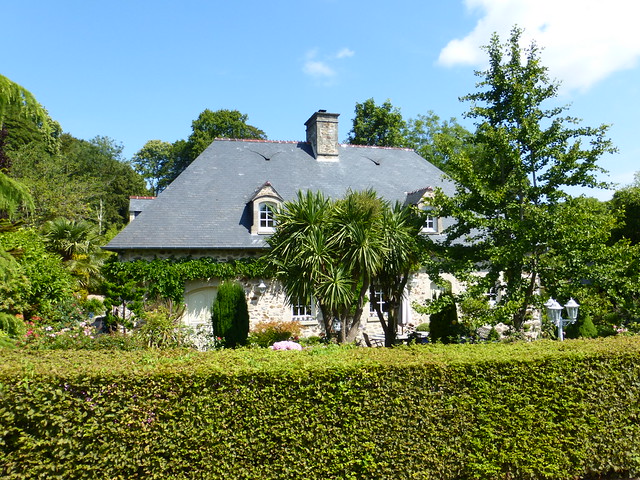 There are a number of lovely houses along the route as well including this charming little cottage with its appealing gardens. Are you interested in owning your own little castle or manor house ?
There are a number of lovely houses along the route as well including this charming little cottage with its appealing gardens. Are you interested in owning your own little castle or manor house ?  This one is located just beside the church and is currently for sale.
This one is located just beside the church and is currently for sale.
Published by The Baguette
-
in
Cotentin
July 2 2014
3
02
/07
/July
/2014
12:05
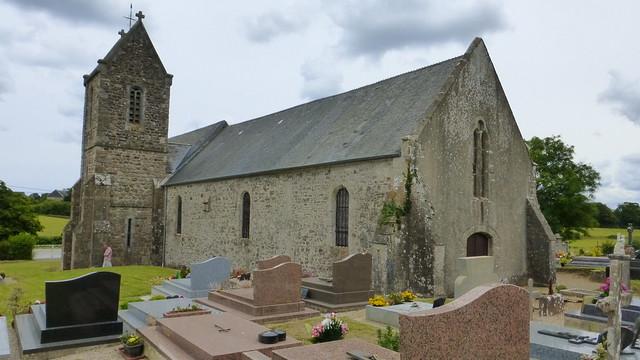
The Église Sainte-Colombe de Crasville is very old and can be dated as far back as the 12th century when it was consecrated by Richard de Bohon, Bishop of Coutances in 1154 under the patronage of the Abbey of Montebourg. It is composed of a choir and nave and lacks a transept. In its present form, it dates from the 17th and 18th century—the only medieval element remaining is the triumphal arch between the chancel and the nave. The bell tower was rebuilt in 1674 and rebuilt again in 1920. The sacristy can be dated to exactly 1722. 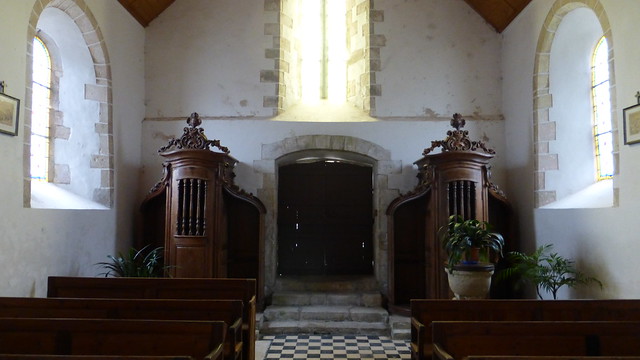
 The value of this church is not its architecture, but by its rich furnishings, a nearly perfect homogeneous grouping of altarpieces, doorways to the sacristy, a rood screen, pulpit, lectern, stools, benches and confessionals.
The value of this church is not its architecture, but by its rich furnishings, a nearly perfect homogeneous grouping of altarpieces, doorways to the sacristy, a rood screen, pulpit, lectern, stools, benches and confessionals. 
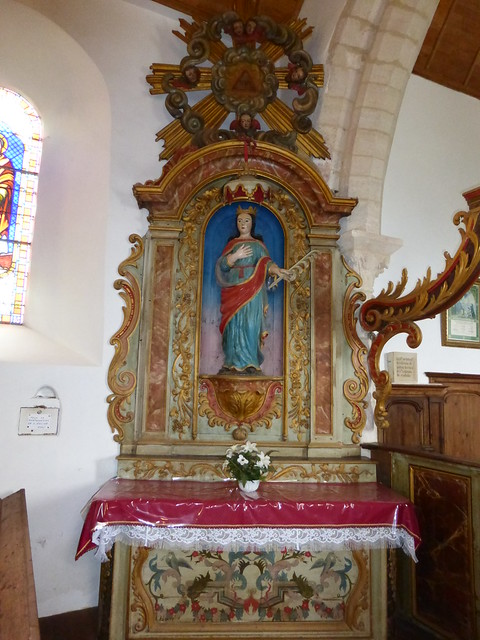
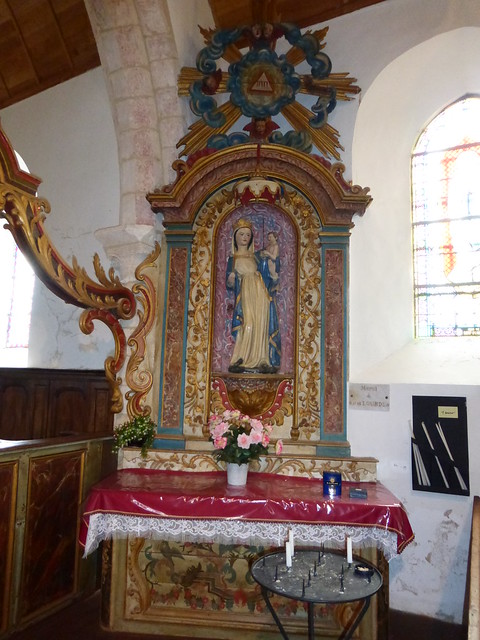 Some pieces are dated with precision: the stalls and the seat for the celebrant date from 1766, the crucifix from 1767 and the confessionals from 1769. What is more fascinating is that all of this liturgical furniture owes its existence to the savings of a small country priest as well as the disinterestedness of a carpenter, Guillaume Godefroy who worked for years at prices far below normal for the time.
Some pieces are dated with precision: the stalls and the seat for the celebrant date from 1766, the crucifix from 1767 and the confessionals from 1769. What is more fascinating is that all of this liturgical furniture owes its existence to the savings of a small country priest as well as the disinterestedness of a carpenter, Guillaume Godefroy who worked for years at prices far below normal for the time. 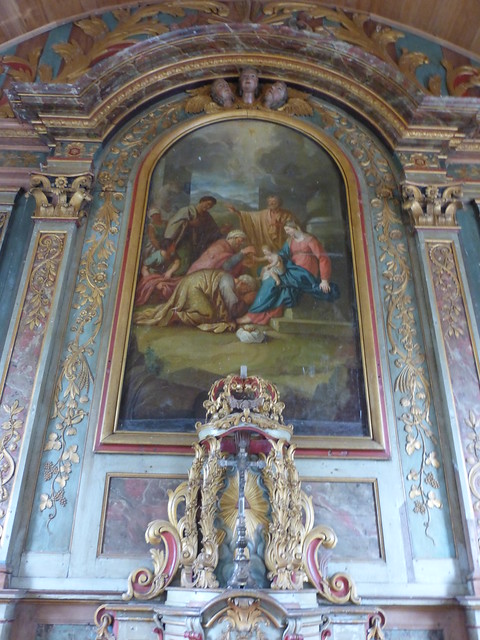 The central panel of the altarpiece represents the Adoration of the Magi.
The central panel of the altarpiece represents the Adoration of the Magi. 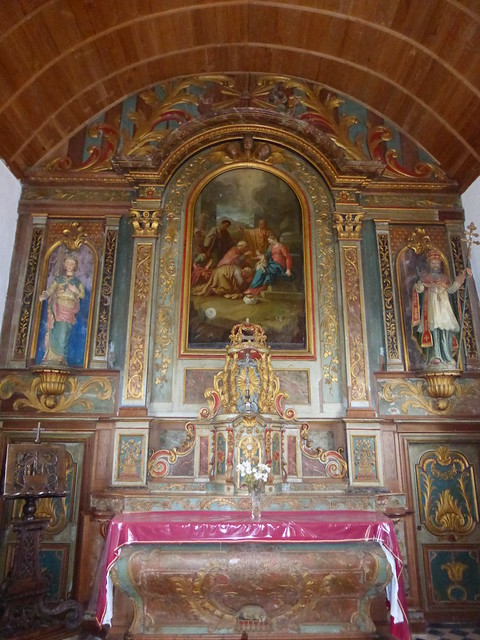 Local flavor is given by the terracotta statues from Sauxemesnil of Sainte-Colombe and Saint-Gregory placed in niches on either side of the altar. Another statue of clay, that of Ste-Catherine, adorns the altar of the small altar to the left. The only medieval church statue is a limestone Madonna and Child from the 14th century located in the southern side altar.
Local flavor is given by the terracotta statues from Sauxemesnil of Sainte-Colombe and Saint-Gregory placed in niches on either side of the altar. Another statue of clay, that of Ste-Catherine, adorns the altar of the small altar to the left. The only medieval church statue is a limestone Madonna and Child from the 14th century located in the southern side altar. 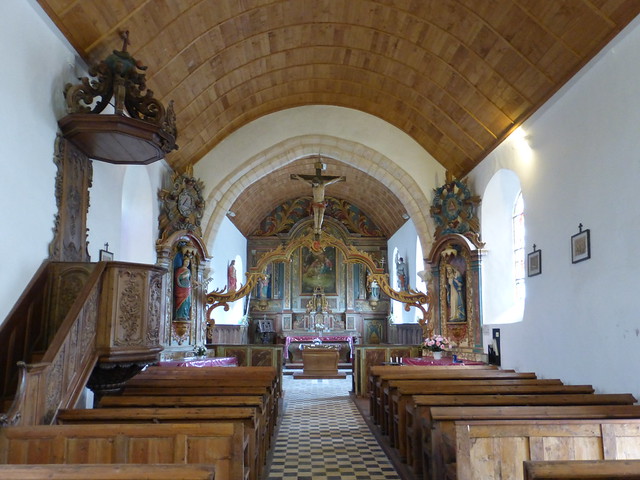 It is said that during the Revolution, officials ordered some men to remove the furniture. They wanted to remove the crucifix of the great rood screen in the nave but found it very difficult. Robert Pilet, faithless man, said, "Wait, let me do it my way." Whereupon he threw a rope over the head of Christ and pulled with all his strength. A man of faith named Nicolas Lequertier, came over to him and intervened saying, "Get away from there or I’ll cut your neck with my own axe!” The Christ remained.
It is said that during the Revolution, officials ordered some men to remove the furniture. They wanted to remove the crucifix of the great rood screen in the nave but found it very difficult. Robert Pilet, faithless man, said, "Wait, let me do it my way." Whereupon he threw a rope over the head of Christ and pulled with all his strength. A man of faith named Nicolas Lequertier, came over to him and intervened saying, "Get away from there or I’ll cut your neck with my own axe!” The Christ remained. 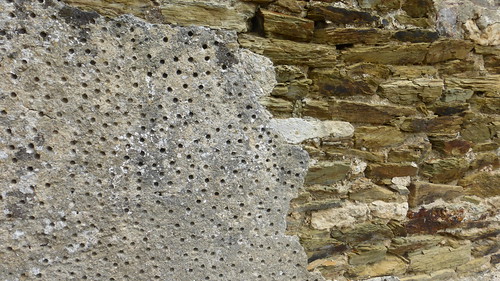
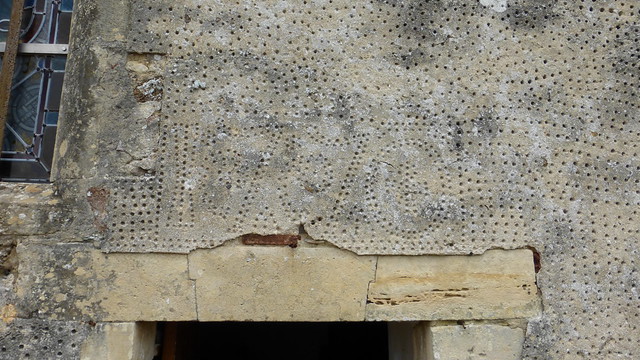 The exterior of the church is covered with a coating dated 1770 above the northern portal. This type of coating is meant to protect the walls from moisture which is not uncommon with churches in the area. The coating, moreover, is decorated with naive drawings created by masons.
The exterior of the church is covered with a coating dated 1770 above the northern portal. This type of coating is meant to protect the walls from moisture which is not uncommon with churches in the area. The coating, moreover, is decorated with naive drawings created by masons. 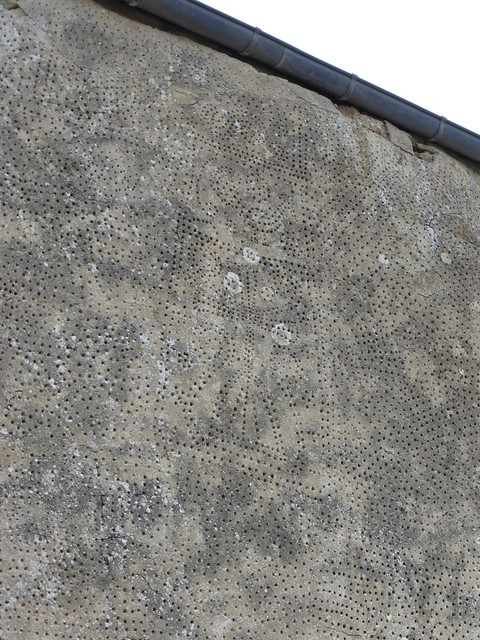
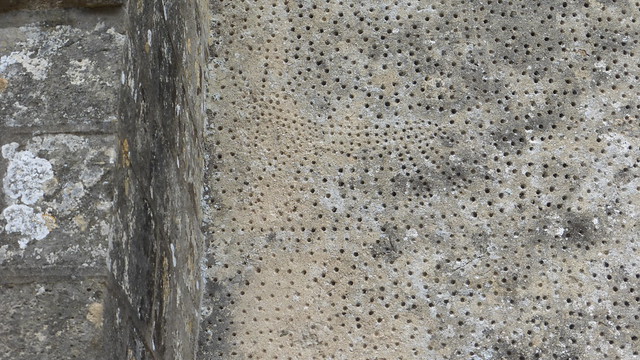 In some cases, it is easy to recognize, among others, a cross or a human figure and a bit to the right, an animal resembling a deer. Along the walls are several old tombstones and even one tomb belonging to a former military officer and friend to the poor of Crasville, Felix François Dursus (1746 – 1811).
In some cases, it is easy to recognize, among others, a cross or a human figure and a bit to the right, an animal resembling a deer. Along the walls are several old tombstones and even one tomb belonging to a former military officer and friend to the poor of Crasville, Felix François Dursus (1746 – 1811).

Published by The Baguette
-
in
Cotentin
June 30 2014
1
30
/06
/June
/2014
09:19
Another beautiful weekend in La Manche ! Lots of sunshine and warm temperatures. On Saturday, I went for another short hike around the town of Lestre. 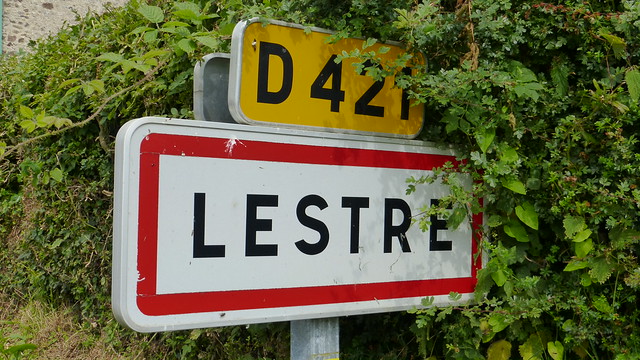 This particular hike was called Randonnée le circuit du Bouillon which roughly translates as the walk around the boiling rapids--an interesting name since there are no rapids to be seen along the streams you have to cross and they are certainly not boiling.
This particular hike was called Randonnée le circuit du Bouillon which roughly translates as the walk around the boiling rapids--an interesting name since there are no rapids to be seen along the streams you have to cross and they are certainly not boiling. 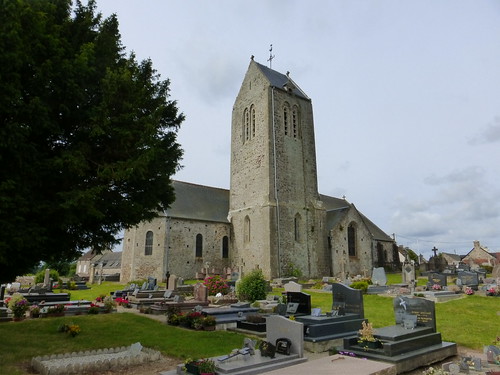
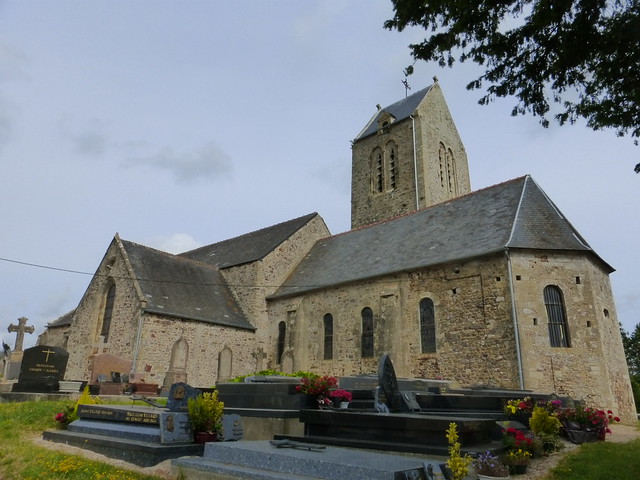 The hike begins in Lestre at the foot of the church of St-Martin, with a typical Normandy saddleback bell tower and doorways that date from the 13th century.
The hike begins in Lestre at the foot of the church of St-Martin, with a typical Normandy saddleback bell tower and doorways that date from the 13th century. 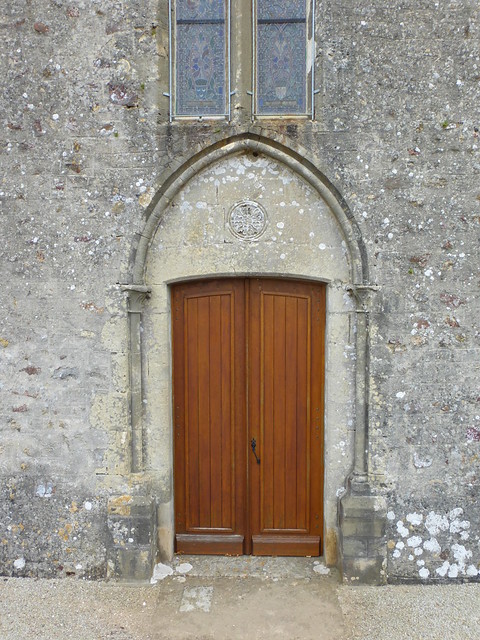
 Inside is a triple aisle nave with two side chapels.
Inside is a triple aisle nave with two side chapels.  I thought the baptismal font was one of the most interesting pieces since it was intricately carved and adorned with quotes from the Bible.
I thought the baptismal font was one of the most interesting pieces since it was intricately carved and adorned with quotes from the Bible.  Above the choir is a “pouter de gloire” or rood screen which separates the main altar from the rest of the church.
Above the choir is a “pouter de gloire” or rood screen which separates the main altar from the rest of the church.  Above the main altar is a wonderful oil painting of the Three Wise Men at the Nativity. On either side are statues of Saint-Martin and Saint John the Baptist.
Above the main altar is a wonderful oil painting of the Three Wise Men at the Nativity. On either side are statues of Saint-Martin and Saint John the Baptist. 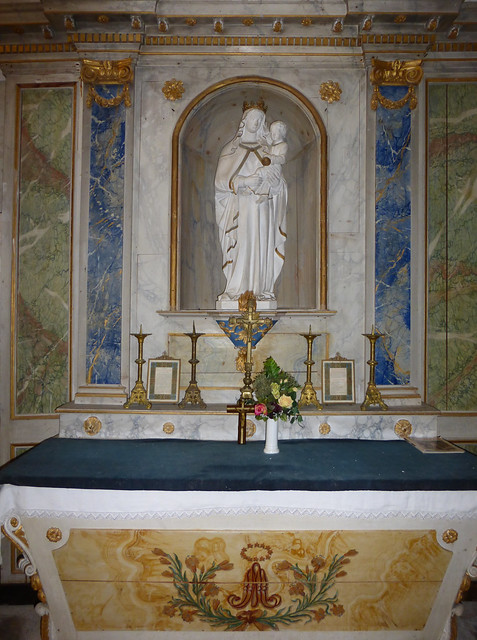
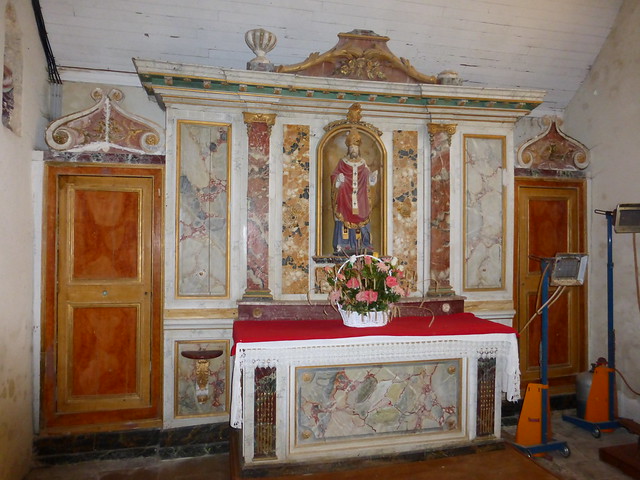 I couldn’t find any more information about the church but as you can see, it has several nice chapels: one dedicated to the Virgin and another to Saint-Martin.
I couldn’t find any more information about the church but as you can see, it has several nice chapels: one dedicated to the Virgin and another to Saint-Martin.  There is also a stained glass window from 1927 created in the workshops of Charles Lorin from Chartes.
There is also a stained glass window from 1927 created in the workshops of Charles Lorin from Chartes. 
 Across the street is the hôtel de ville with its newly restored arches.
Across the street is the hôtel de ville with its newly restored arches. 
 The hiking path takes you through farmers’ fields along poorly kept paths lined with wildflowers and weeds.
The hiking path takes you through farmers’ fields along poorly kept paths lined with wildflowers and weeds. 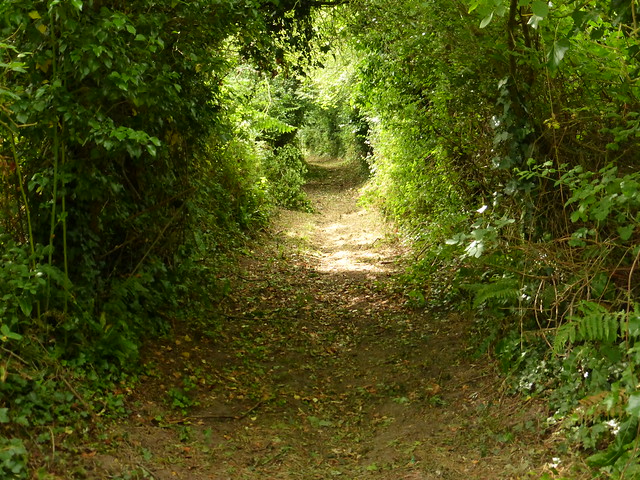

 At times, one can get a fairly decent view of the Tourville castle, a private residence built in the 18th century by Jean-Louis Avice de Tourville .
At times, one can get a fairly decent view of the Tourville castle, a private residence built in the 18th century by Jean-Louis Avice de Tourville . 
 Just 400 meters away along a path marked private property is the most important motte féodale (motte-and-bailey castle) in Normandy. It dates from the 10th century and is in need of some restoration—the roof has collapsed and it is covered with vines.
Just 400 meters away along a path marked private property is the most important motte féodale (motte-and-bailey castle) in Normandy. It dates from the 10th century and is in need of some restoration—the roof has collapsed and it is covered with vines. 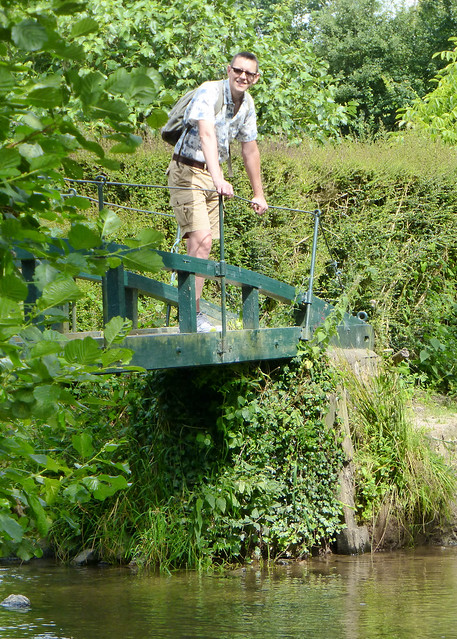 At one point, you have to cross a river called la Sinope which empties into the sea at Quinéville.
At one point, you have to cross a river called la Sinope which empties into the sea at Quinéville. 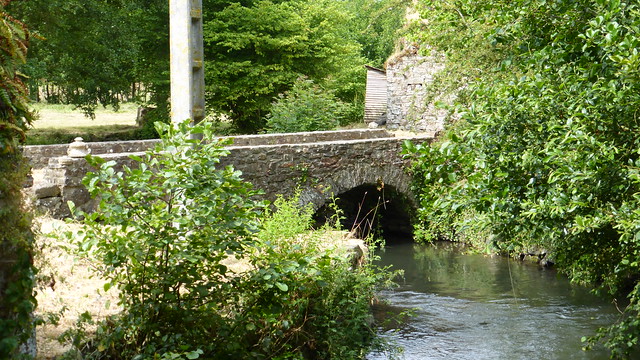 Just beside the passerelle is another stone bridge which was also marked as private property.
Just beside the passerelle is another stone bridge which was also marked as private property.  It is still too early in the summer to see roadways and country lanes full of foxglove, but there are a few areas where they are starting to bloom.
It is still too early in the summer to see roadways and country lanes full of foxglove, but there are a few areas where they are starting to bloom. 

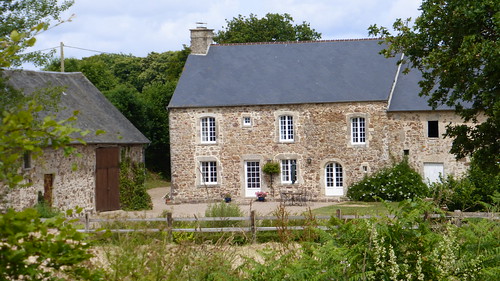
 Passing the Moulin de Rey, there are several old manor houses and stone farm buildings.
Passing the Moulin de Rey, there are several old manor houses and stone farm buildings. 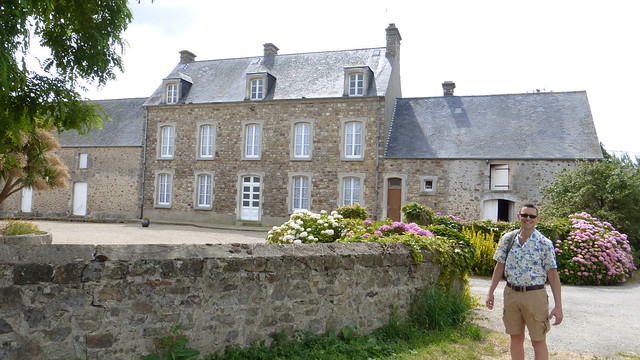 What do you think of my new shirt ? I bought it on Friday at H&M during sales week--got a whole new summer wardrobe for under 90 Euros !
What do you think of my new shirt ? I bought it on Friday at H&M during sales week--got a whole new summer wardrobe for under 90 Euros ! 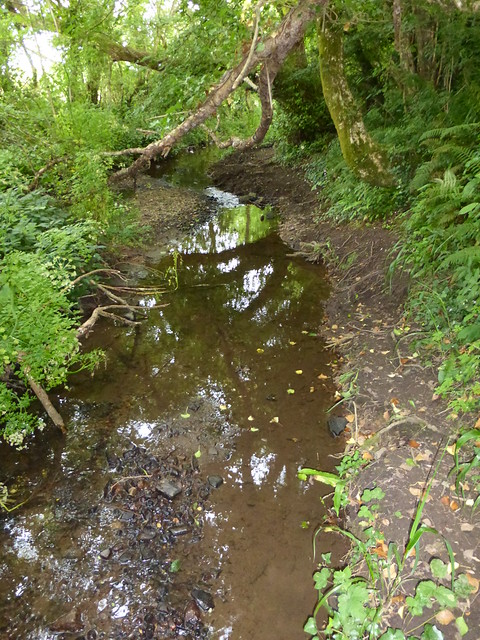 The trickiest part of the walk is a 200 meter stretch along the la Sinope where the path is actually just a trek along the riverside through mud and overgrown shrubs.
The trickiest part of the walk is a 200 meter stretch along the la Sinope where the path is actually just a trek along the riverside through mud and overgrown shrubs. 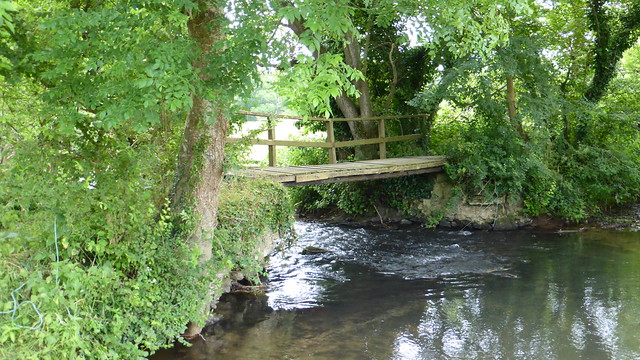 This last bridge is called le pont bleu but its name has nothing to do with the color blue. By the time I finished walking, it was almost 2pm and I was getting rather hungry. Fortunately, I packed a lunch with me and decided to drive to the old ruins of the Chapelle St-Michel where I sat and had my lunch.
This last bridge is called le pont bleu but its name has nothing to do with the color blue. By the time I finished walking, it was almost 2pm and I was getting rather hungry. Fortunately, I packed a lunch with me and decided to drive to the old ruins of the Chapelle St-Michel where I sat and had my lunch. 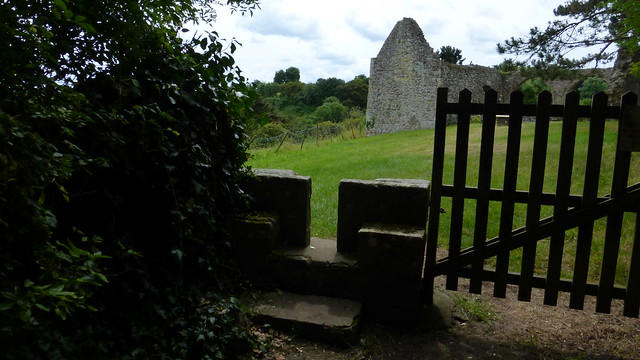 The chapel of Saint-Michel is actually a ruin from the first third of the 12th century.
The chapel of Saint-Michel is actually a ruin from the first third of the 12th century. 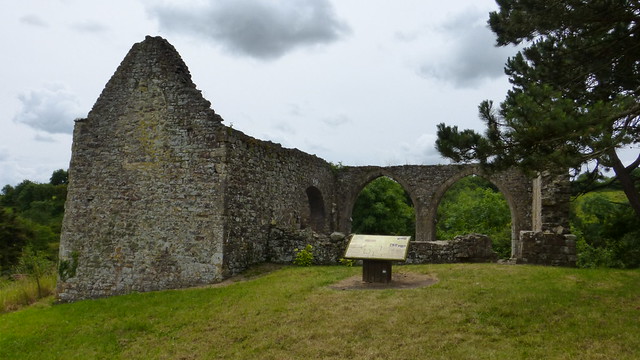 The chapel depended on the abbey of Blanchelande and was first mentioned in writings from 1160.
The chapel depended on the abbey of Blanchelande and was first mentioned in writings from 1160. 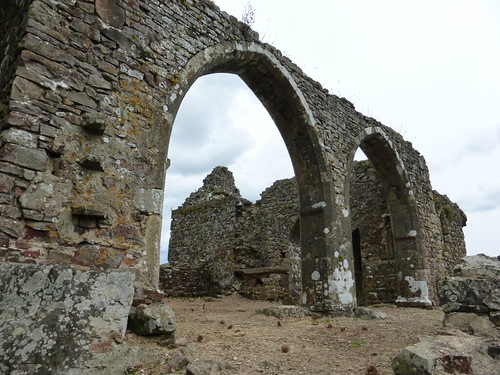
 After the French Revolution, it was sold and its remaining stones were looted.
After the French Revolution, it was sold and its remaining stones were looted. 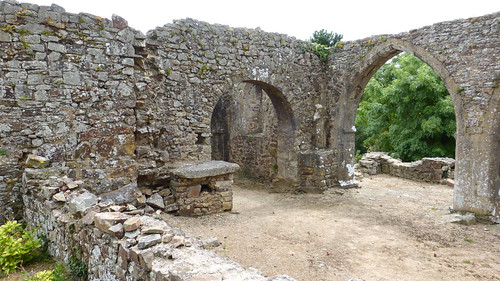

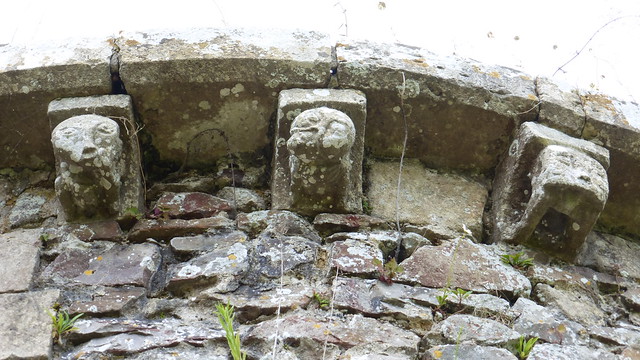
 The apse decorated with corbels of animal and human faces.
The apse decorated with corbels of animal and human faces.  These are two of the broken arches that formed the aisle.
These are two of the broken arches that formed the aisle.  This is a statue of the Holy Trinity. Within the transept is a Gothic chapel with several statues including those of St-Côme and St-Damien as well as a recumbent effigy along one of the walls.
This is a statue of the Holy Trinity. Within the transept is a Gothic chapel with several statues including those of St-Côme and St-Damien as well as a recumbent effigy along one of the walls. 
 Other statues are only fragments such as this one of St-Jacques.
Other statues are only fragments such as this one of St-Jacques. 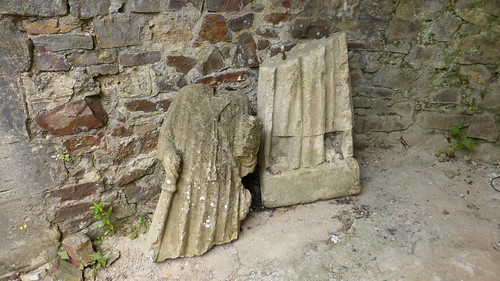
 Through a small window in the apse, one has a good view of the sea. This same window is formed with stones laid out in a pattern called arête-de-poisson, or fish bones.
Through a small window in the apse, one has a good view of the sea. This same window is formed with stones laid out in a pattern called arête-de-poisson, or fish bones.
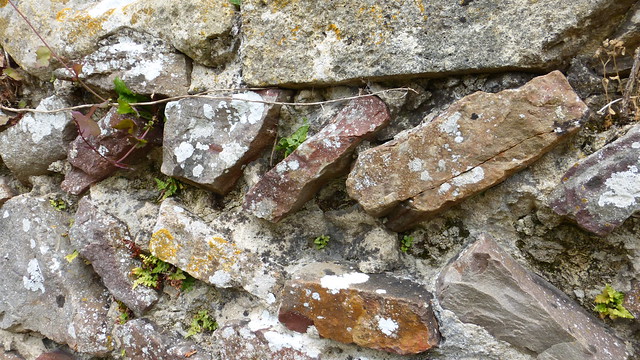
Published by The Baguette
-
in
Cotentin
June 29 2014
7
29
/06
/June
/2014
17:07
After a day of hiking and then a visit to the German gun batteries, I then drove to Montebourg to visit the Abbaye Sainte-Marie. Strangely enough I've never been there even though it's so close to Cherbourg. 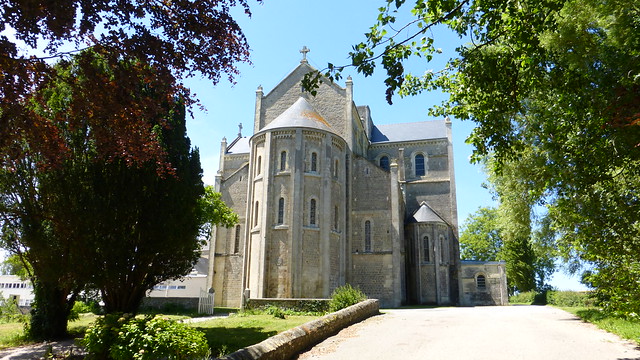

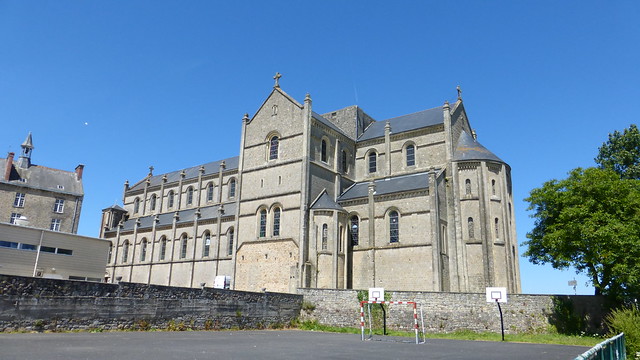 The origins of the abbey can be traced back to William the Conqueror in the second half of the 11th century but its legendary beginnings are a lot more interesting, albeit a lot more far-fetched (read it for yourself... I don't think it would be a miracle if someone came ashore in a boat one morning, would you ?) Anyway, the legend, written down in the 15th century, tells of two monks from the Savoie who spent the night on a Normandy beach. One of them (no name given) decided to sleep in a boat that had washed up on the shore; the second, Roger, preferred to sleep on the beach.
The origins of the abbey can be traced back to William the Conqueror in the second half of the 11th century but its legendary beginnings are a lot more interesting, albeit a lot more far-fetched (read it for yourself... I don't think it would be a miracle if someone came ashore in a boat one morning, would you ?) Anyway, the legend, written down in the 15th century, tells of two monks from the Savoie who spent the night on a Normandy beach. One of them (no name given) decided to sleep in a boat that had washed up on the shore; the second, Roger, preferred to sleep on the beach. 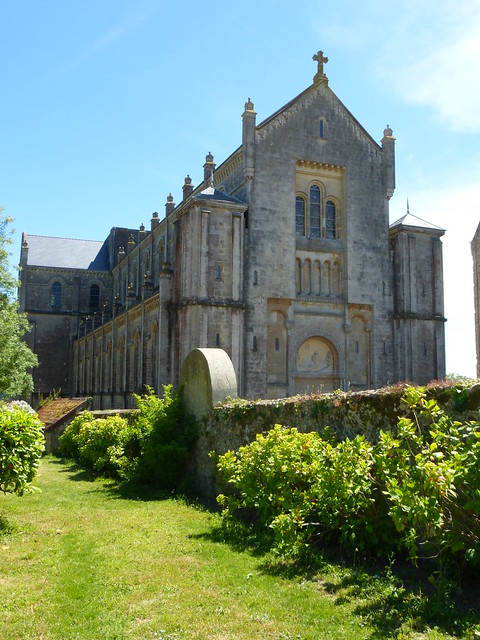

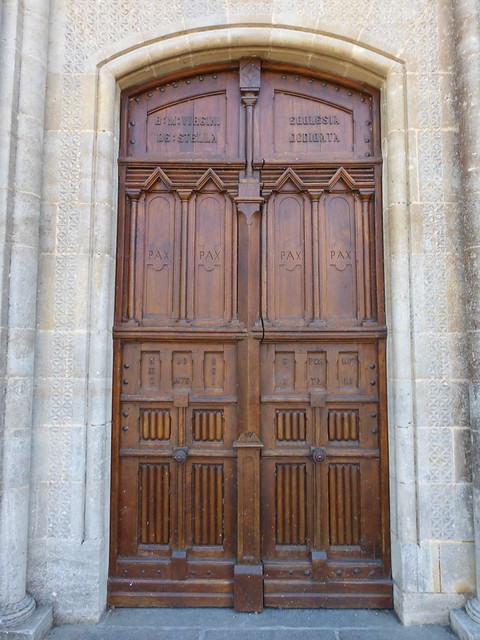 The tide carried the boat and its occupant all the way to the English coast where he was elected bishop by the people who were stunned by this "miracle". In Normandy the next morning, Roger went in search of his companion who disappeared. Tired, he stopped one night at the foot of a hill in Montebourg. He fell asleep and dreamt that a star had fallen on top of the hill. The Virgin appeared to him and told him that he must build a chapel there in her honor. Upon hearing of these events, Duke William gave Roger land, materials and various rights in the forests of the Cotentin in order for Roger to build his monastery. The abbaye de Montebourg was consecrated only in 1152, in the presence of the Archbishop of Rouen Hugh of Amiens, the bishops of Coutances and Evreux, and local lords, including Guillaume de Vernon, patron and protector of the abbey. The buildings were destroyed during and after the French Revolution, but the church was rebuilt in neo-Romanesque style between 1892 and 1933. Today, the abbey buildings are occupied by a private agricultural junior high and high school.
The tide carried the boat and its occupant all the way to the English coast where he was elected bishop by the people who were stunned by this "miracle". In Normandy the next morning, Roger went in search of his companion who disappeared. Tired, he stopped one night at the foot of a hill in Montebourg. He fell asleep and dreamt that a star had fallen on top of the hill. The Virgin appeared to him and told him that he must build a chapel there in her honor. Upon hearing of these events, Duke William gave Roger land, materials and various rights in the forests of the Cotentin in order for Roger to build his monastery. The abbaye de Montebourg was consecrated only in 1152, in the presence of the Archbishop of Rouen Hugh of Amiens, the bishops of Coutances and Evreux, and local lords, including Guillaume de Vernon, patron and protector of the abbey. The buildings were destroyed during and after the French Revolution, but the church was rebuilt in neo-Romanesque style between 1892 and 1933. Today, the abbey buildings are occupied by a private agricultural junior high and high school. 
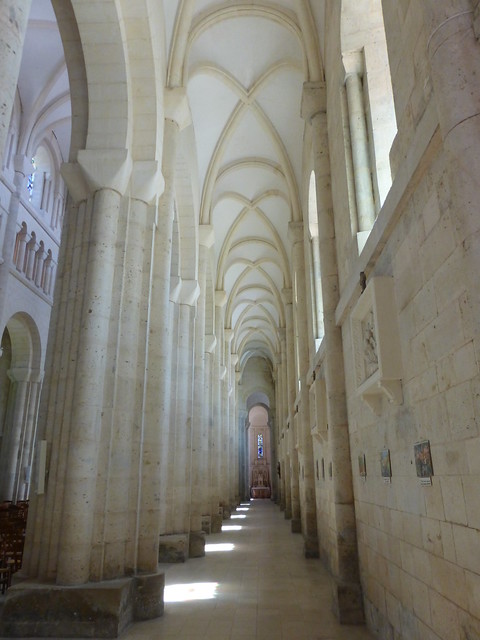

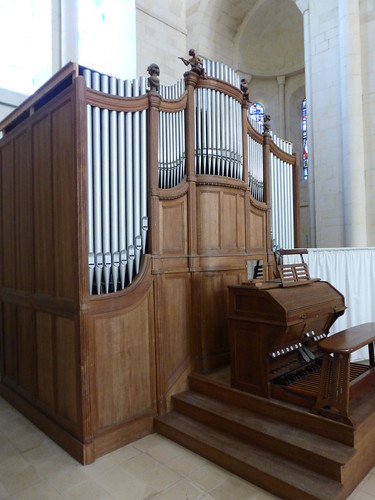 The interior is very clean and bathed in light from the stained glass installed in the 1950s.
The interior is very clean and bathed in light from the stained glass installed in the 1950s. 


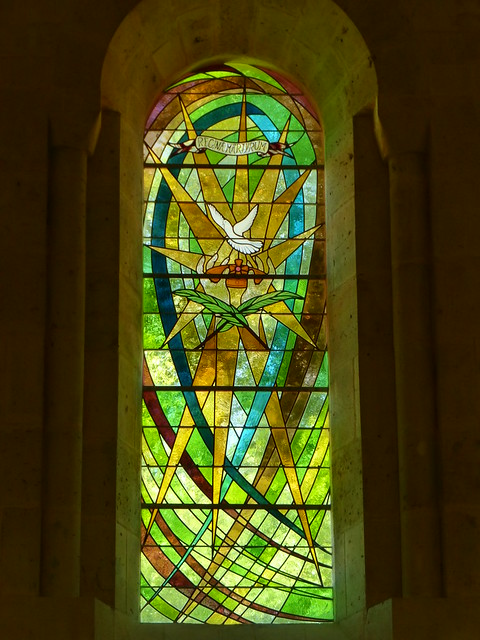 There were so many splashes of color along the floors and walls. It isn't very often you see such a rainbow.
There were so many splashes of color along the floors and walls. It isn't very often you see such a rainbow. 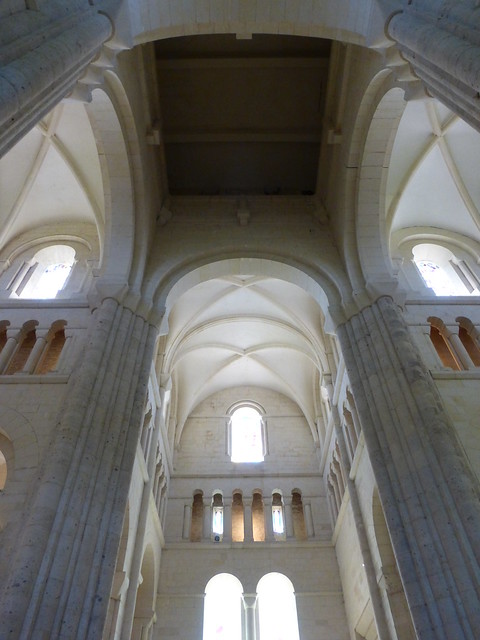
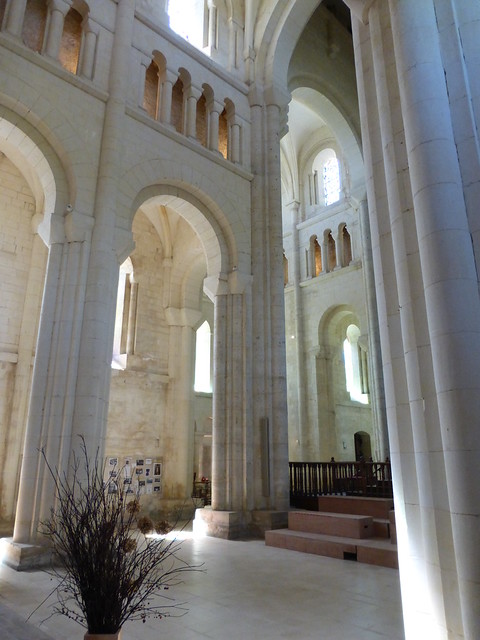

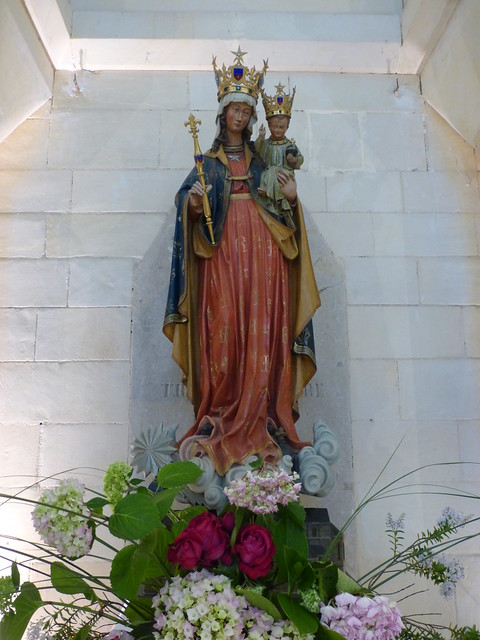 Along the norhtern wall is the chapel devoted to Notre-Dame de l'Étoile (Our Lady of the Star) where worshipers come to pray for world peace. After visiting the abbey and the grounds, I drove into the town to visit l'église Saint-Jacques. It was partially destroyed during World War II and there are still some bullet impacts along the exterior walls.
Along the norhtern wall is the chapel devoted to Notre-Dame de l'Étoile (Our Lady of the Star) where worshipers come to pray for world peace. After visiting the abbey and the grounds, I drove into the town to visit l'église Saint-Jacques. It was partially destroyed during World War II and there are still some bullet impacts along the exterior walls.  Its construction was decided upon by the Abbé de Montebourg at the beginning of the 15th century and it was consecrated on September 2, 1329 by the Bishop of Coutances, Guillaume de Thieuville. It is rather dark inside and there are a few things of interest to see.
Its construction was decided upon by the Abbé de Montebourg at the beginning of the 15th century and it was consecrated on September 2, 1329 by the Bishop of Coutances, Guillaume de Thieuville. It is rather dark inside and there are a few things of interest to see.  For starters, there is the baptismal font which is actually an old column capital adorned with animal faces and an intricate interlace pattern. It dates from the 11th century.
For starters, there is the baptismal font which is actually an old column capital adorned with animal faces and an intricate interlace pattern. It dates from the 11th century. 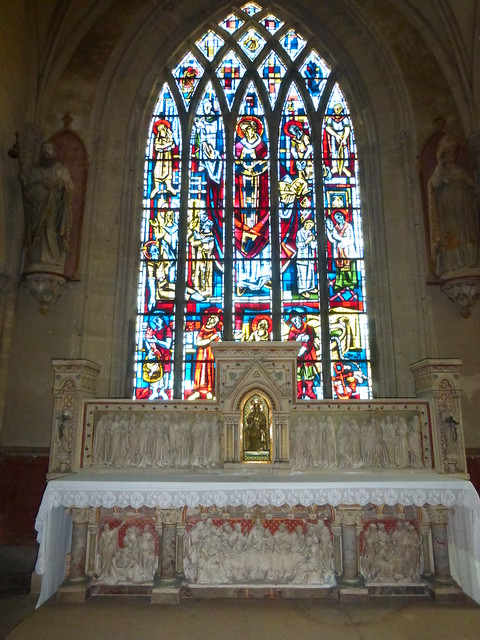 Behind the rather uninspired main altar is the original high altar adorned in bas-reliefs and backlit with a large stained glass window.
Behind the rather uninspired main altar is the original high altar adorned in bas-reliefs and backlit with a large stained glass window. 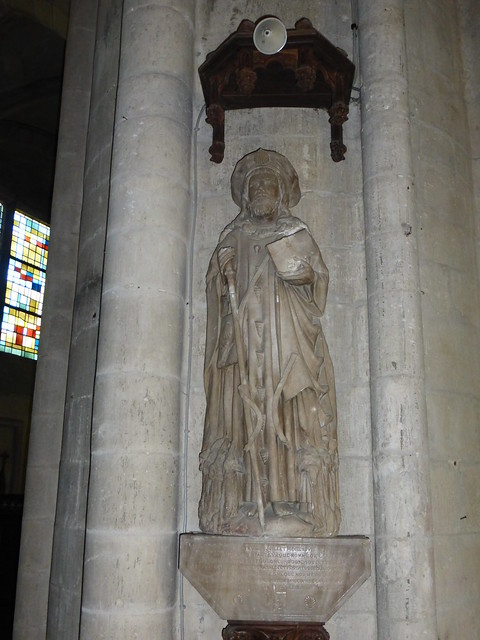 There is also a statue of St-Jacques in the choir from the 14th century.
There is also a statue of St-Jacques in the choir from the 14th century.  Another 14th century statue of St-Jacques stands outside above the portal to the church.
Another 14th century statue of St-Jacques stands outside above the portal to the church. 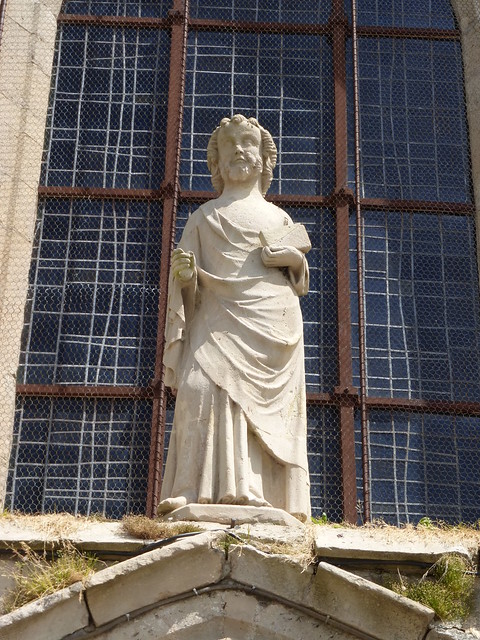 In July, there is a solemnity to the town's patron saint and the parishoners crown the statue with roses. To finish the day, I wanted to find a place that served ice cream but could only find a chocolate maker, Territoires Chocolats where everything could be tasted before buying. Wouldn't you know it, as I was driving out of town, I saw a sign for ice cream just outside of a resturant near the chocolatier--just another example of my luck (or lack of) in life.
In July, there is a solemnity to the town's patron saint and the parishoners crown the statue with roses. To finish the day, I wanted to find a place that served ice cream but could only find a chocolate maker, Territoires Chocolats where everything could be tasted before buying. Wouldn't you know it, as I was driving out of town, I saw a sign for ice cream just outside of a resturant near the chocolatier--just another example of my luck (or lack of) in life.

Published by The Baguette
-
in
Cotentin
June 27 2014
5
27
/06
/June
/2014
09:05
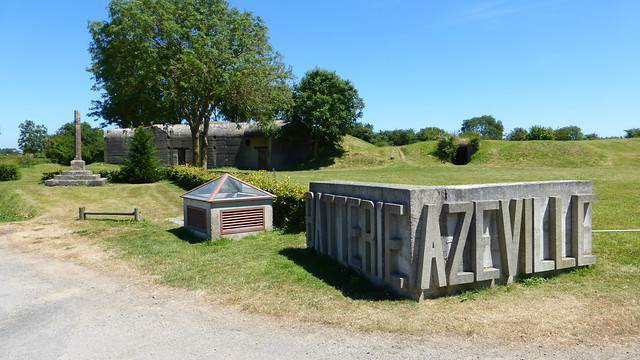
The Azeville German Coastal Battery is just north of Sainte-Mère-Eglise near the small town of Azeville about 10 km from Utah Beach. It is one of the first constructions of the Atlantic Wall in France by the Todt Organization of the Third Reich. 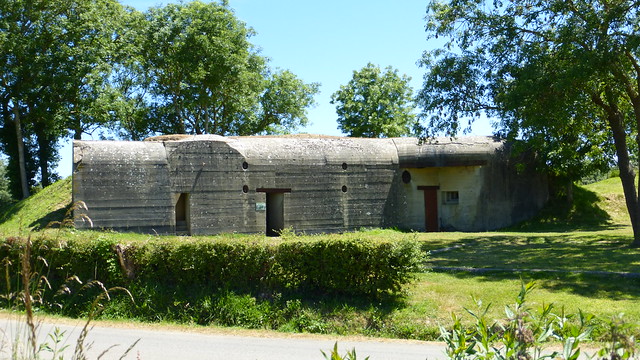 Built in 1941, it established the presence of the German army along the coast of La Manche. It used a camouflage painted stone to blend in with village houses.
Built in 1941, it established the presence of the German army along the coast of La Manche. It used a camouflage painted stone to blend in with village houses. 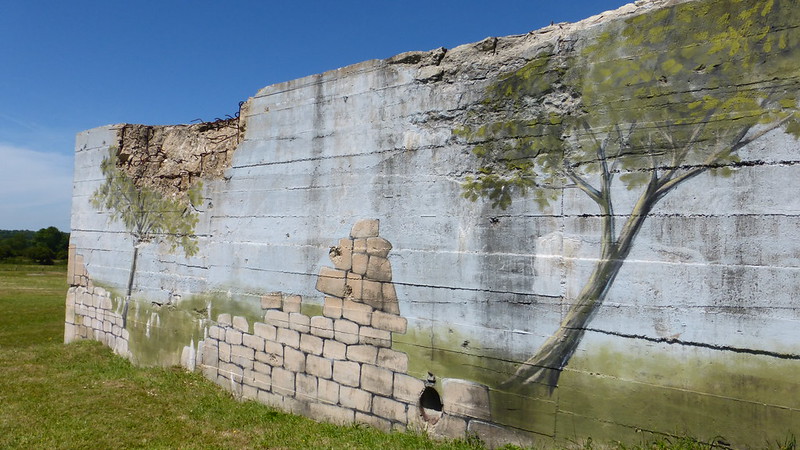

 It included two bunkers of type H650 and another two with type H671, each housing a French Schneider 105 mm gun from the First World War. These guns were powerful but had less of a range than those of the neighboring battery at Crisbecq.
It included two bunkers of type H650 and another two with type H671, each housing a French Schneider 105 mm gun from the First World War. These guns were powerful but had less of a range than those of the neighboring battery at Crisbecq. 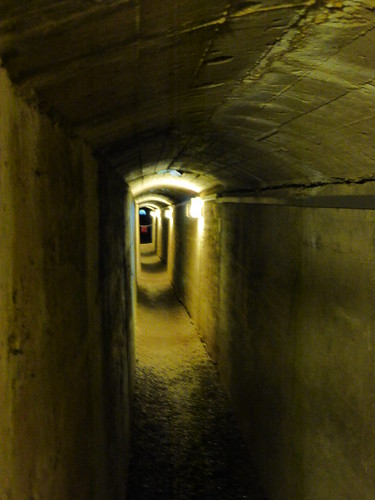
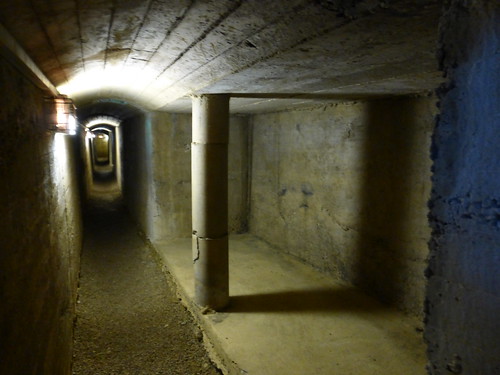
 Over 300 meters of underground galleries linked the various shelters, bunkers and defense posts. Located so far inland that it did not have a direct view of the sea, it had to rely on shooting directions from the battery at Crisbecq.
Over 300 meters of underground galleries linked the various shelters, bunkers and defense posts. Located so far inland that it did not have a direct view of the sea, it had to rely on shooting directions from the battery at Crisbecq. 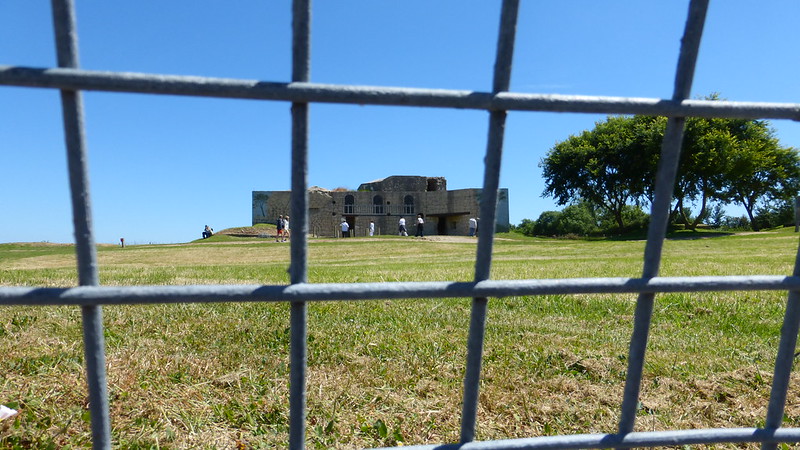
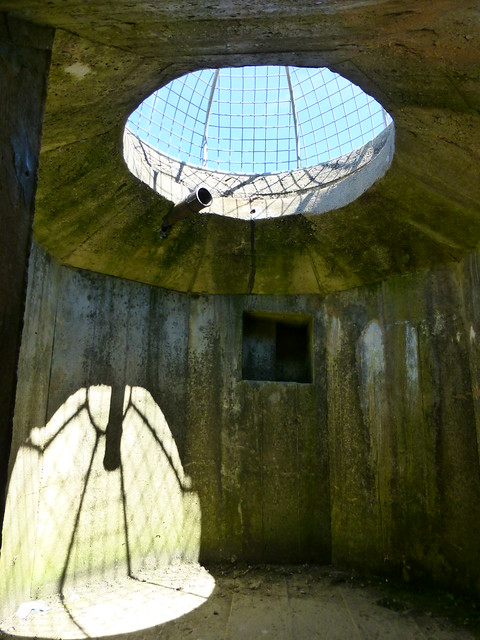
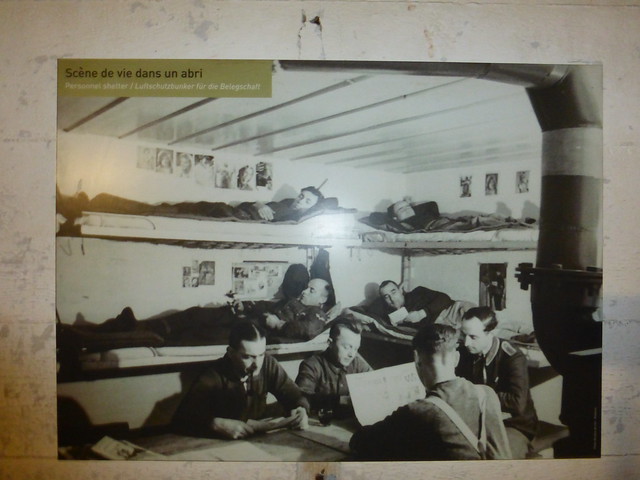
 A garrison of 170 men served and defended this battery commanded by Commander Treiber and Captain Kattnig. The majority of men bivouacked near the battery, while the officers were accommodated in the village. In 1943 the guns received a prominent visitor when Erwin Rommel inspected the building site. After his visit work began to expand the installation and the guns that were previously placed in open positions were now built into concrete pillboxes, even though the Germans did not believe that the coast in front of the battery was under threat of invasion.
A garrison of 170 men served and defended this battery commanded by Commander Treiber and Captain Kattnig. The majority of men bivouacked near the battery, while the officers were accommodated in the village. In 1943 the guns received a prominent visitor when Erwin Rommel inspected the building site. After his visit work began to expand the installation and the guns that were previously placed in open positions were now built into concrete pillboxes, even though the Germans did not believe that the coast in front of the battery was under threat of invasion. 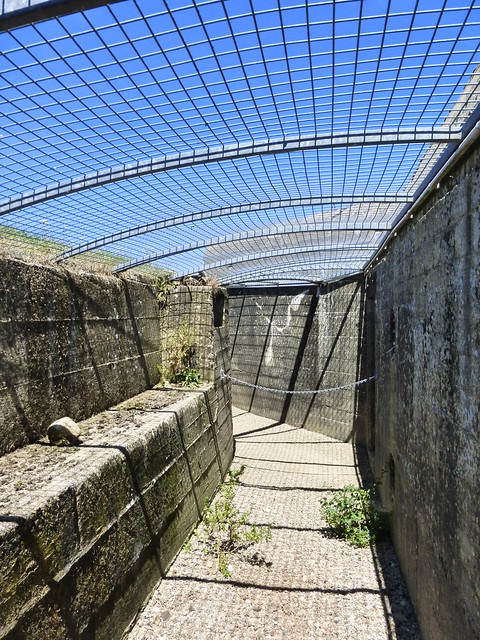

 Because the calibre of the four guns was only 105 mm, when the Allies landed on the nearby Utah Beach on 6th June 1944 (D-day) they were firing at maximum range and accuracy was therefore not optimal. Despite this, the Germans managed to keep the Americans on Utah under fire for two days, preventing further advances.
Because the calibre of the four guns was only 105 mm, when the Allies landed on the nearby Utah Beach on 6th June 1944 (D-day) they were firing at maximum range and accuracy was therefore not optimal. Despite this, the Germans managed to keep the Americans on Utah under fire for two days, preventing further advances. 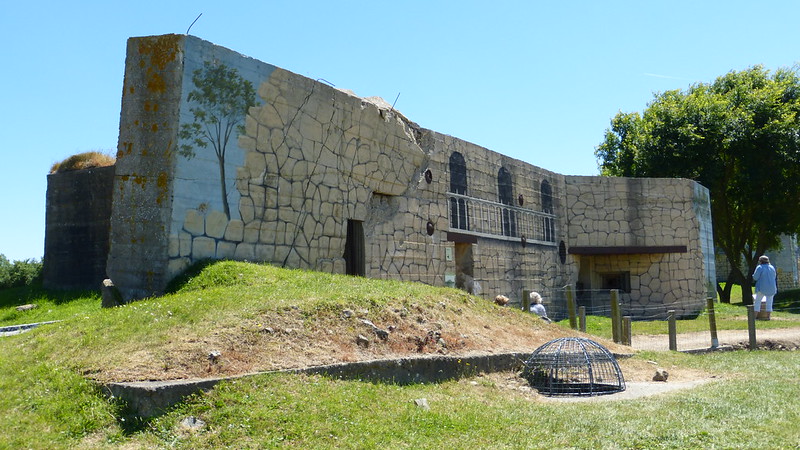
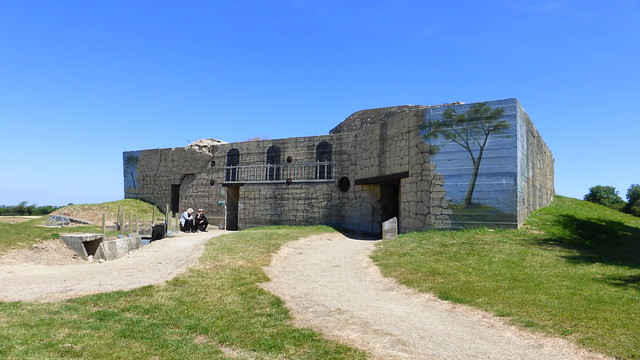 On 9th June the 170 soldiers at the Crisbecq battery surrendered and a massive bombardment of Azeville by Allied warships started. Eventually the battery was attacked by U.S. troops equipped with flame throwers.
On 9th June the 170 soldiers at the Crisbecq battery surrendered and a massive bombardment of Azeville by Allied warships started. Eventually the battery was attacked by U.S. troops equipped with flame throwers. 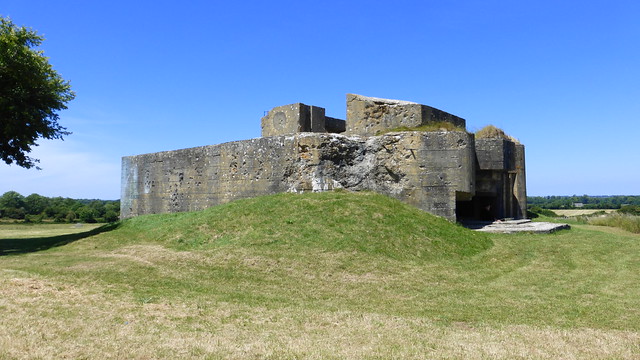
 The garrison surrendered and the fight for Azeville was over.
The garrison surrendered and the fight for Azeville was over. 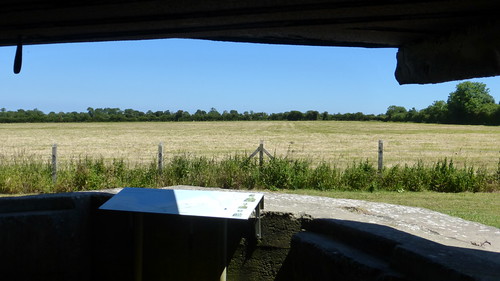 Standing inside one of the gun casemates, where the gun is long gone, you can look out of the narrow opening towards the coast.
Standing inside one of the gun casemates, where the gun is long gone, you can look out of the narrow opening towards the coast. 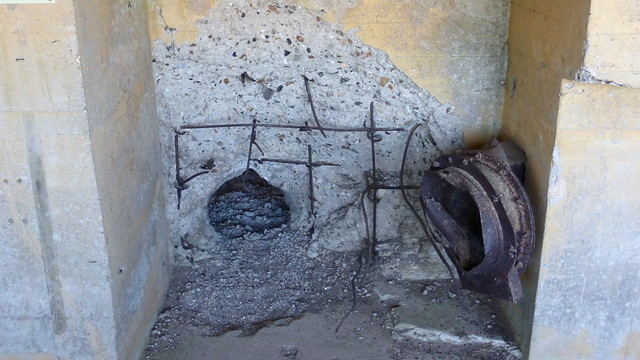 At the back wall, down at floor level, is a sizable hole in the concrete wall.
At the back wall, down at floor level, is a sizable hole in the concrete wall. 
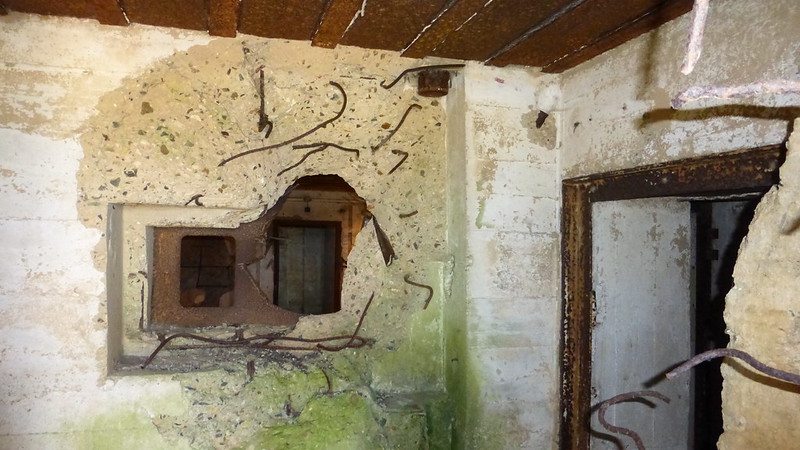 Walking through the door, into the ammunition room behind, the hole on the other size is a bit bigger and there is a large gouge in the concrete floor. Apparently this is one of the rounds that came from the SS Nevada.
Walking through the door, into the ammunition room behind, the hole on the other size is a bit bigger and there is a large gouge in the concrete floor. Apparently this is one of the rounds that came from the SS Nevada. 

 Nearby is the Crisbecq Battery, the largest coastal artillery battery on Utah-Beach, with its 21 pillboxes linked by over a kilometre of trenches covering a total area of 4 hectares.
Nearby is the Crisbecq Battery, the largest coastal artillery battery on Utah-Beach, with its 21 pillboxes linked by over a kilometre of trenches covering a total area of 4 hectares. 
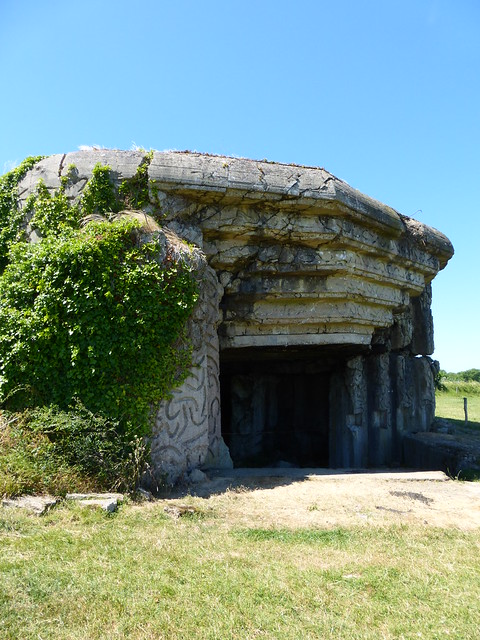
 I didn’t pay to visit the entire site but maybe I’ll go back some other day. Meanwhile, there is a plethora of information about it at this site along with some very interesting photos.
I didn’t pay to visit the entire site but maybe I’ll go back some other day. Meanwhile, there is a plethora of information about it at this site along with some very interesting photos.


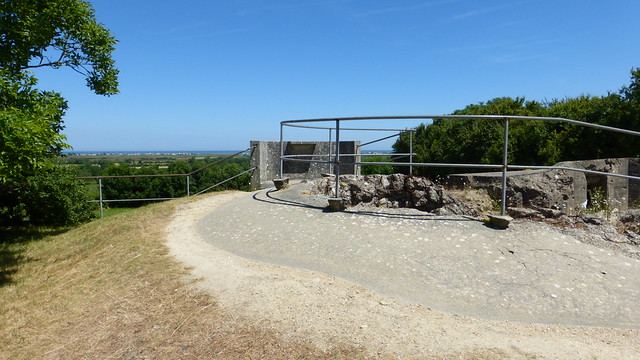
Published by The Baguette
-
in
Cotentin
June 22 2014
7
22
/06
/June
/2014
09:15
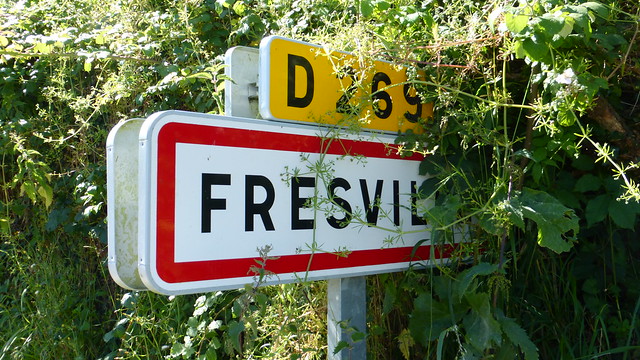
Yesterday was such a beautiful day that I decided to go hiking. Looked online for a destination and decided on a short ramble in and around the small town of Fresville.  My first stop was the Eglise Saint-Martin with its 12th century Romanesque nave. The choir and transept are gothic and date from the 14th and 15th centuries. The bell tower was built in the 14th century.
My first stop was the Eglise Saint-Martin with its 12th century Romanesque nave. The choir and transept are gothic and date from the 14th and 15th centuries. The bell tower was built in the 14th century. 
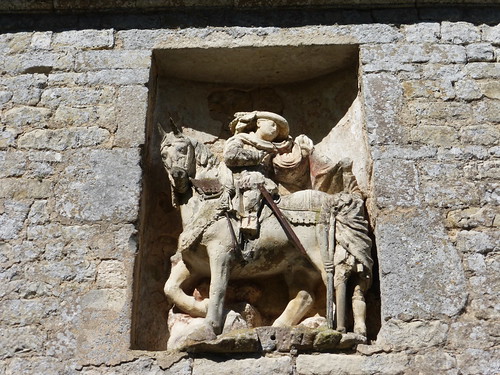 Outside, along the apsidal wall is a bas-relief entitled La Charité de Saint-Martin.
Outside, along the apsidal wall is a bas-relief entitled La Charité de Saint-Martin.  Upon entering, one first sees the baptismal font to the right and then, looking up, admires the beautiful wood ceiling and its crossbeams.
Upon entering, one first sees the baptismal font to the right and then, looking up, admires the beautiful wood ceiling and its crossbeams. 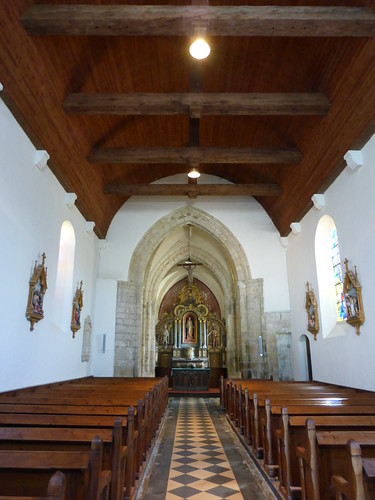
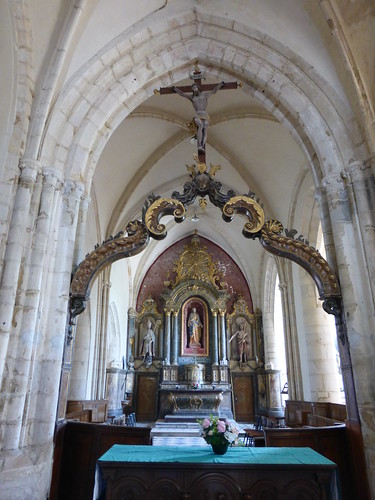 Just above the modern main altar is a “poutre de gloire” or rood beam from the 18th century with a 17th century crucifixion.
Just above the modern main altar is a “poutre de gloire” or rood beam from the 18th century with a 17th century crucifixion.  The secondary chapel to the left is dedicated to Saint-Sebastien.
The secondary chapel to the left is dedicated to Saint-Sebastien. 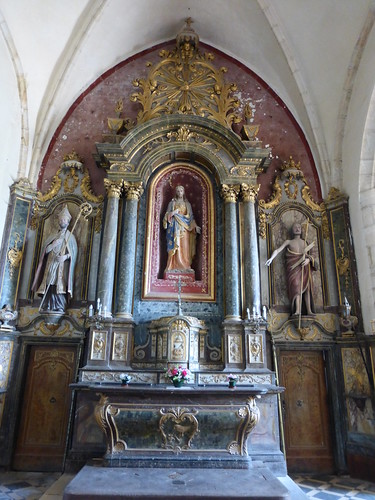 The high altar from the 18th century has four columns separating the two statues of Saint-Sulpice and Saint-John the Baptist from a niche which holds a statue of the Sacred Heart of Jesus.
The high altar from the 18th century has four columns separating the two statues of Saint-Sulpice and Saint-John the Baptist from a niche which holds a statue of the Sacred Heart of Jesus. 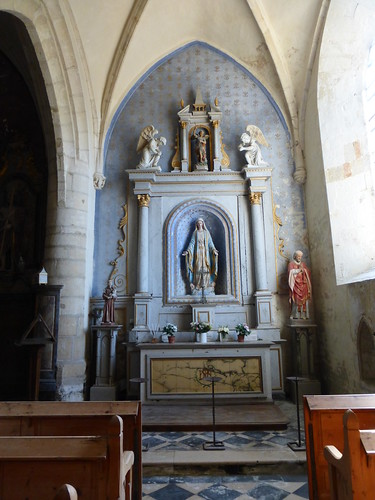 To the right is another transept chapel dedicated to the Virgin. The aisle has two beautiful stained glass windows from the glassmakers at La Maison Bazin-Latteux de Mesnil-Saint-Firmin in the Oise.
To the right is another transept chapel dedicated to the Virgin. The aisle has two beautiful stained glass windows from the glassmakers at La Maison Bazin-Latteux de Mesnil-Saint-Firmin in the Oise. 
 These date from 1877 and were donated to the church by members of the parish. In the Middle Ages, most abbeys and bishoprics had not one church but many associated sanctuaries, serving distinct purposes. In the Cotentin, this phenomenon is well illustrated by two religious buildings barely ten meters apart in Fresville.
These date from 1877 and were donated to the church by members of the parish. In the Middle Ages, most abbeys and bishoprics had not one church but many associated sanctuaries, serving distinct purposes. In the Cotentin, this phenomenon is well illustrated by two religious buildings barely ten meters apart in Fresville.  Just next to the church of Saint-Martin is the Chapelle Sainte-Sulpice from the 16th century. It was not open when I was there so I have no idea what it looks like inside.
Just next to the church of Saint-Martin is the Chapelle Sainte-Sulpice from the 16th century. It was not open when I was there so I have no idea what it looks like inside. 
 The area around Fresville is dotted with several old manor houses and large stone farm buildings—many of which have been restored and are privately owned or rented out as bed and breakfasts or holiday getaways.
The area around Fresville is dotted with several old manor houses and large stone farm buildings—many of which have been restored and are privately owned or rented out as bed and breakfasts or holiday getaways. 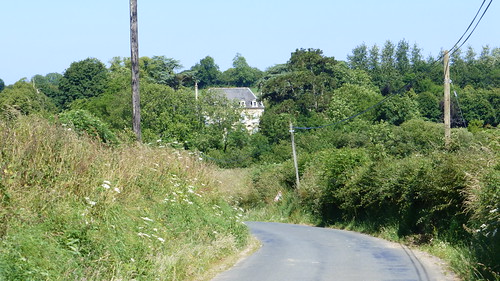
 This one is a private residence called the Manoir de Tamerville.
This one is a private residence called the Manoir de Tamerville. 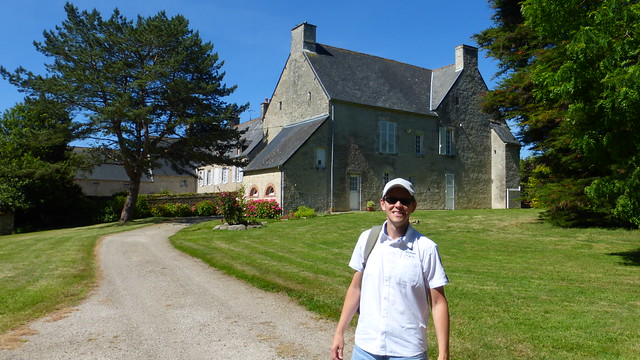 Across the street is another beautiful home called Le Hesnay.
Across the street is another beautiful home called Le Hesnay. 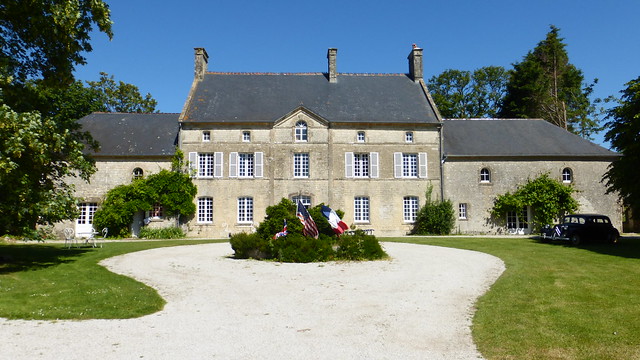 Perhaps the grandest of them all is the Manoir de Grainville which is now a chambre d’hôtes. The walk takes you through fields of corn, grain and grasses as well as many cow pastures all located within the low-lying marshlands known as the marais.
Perhaps the grandest of them all is the Manoir de Grainville which is now a chambre d’hôtes. The walk takes you through fields of corn, grain and grasses as well as many cow pastures all located within the low-lying marshlands known as the marais. 
 Also along the road is a small memorial to the men of the 505th US Parachute Infantry Regiment who were gunned down by Nazi soldiers during the D-Day landings. The ashes of one of the soldiers, William H. Tucker are placed here. He passed away in 2008.
Also along the road is a small memorial to the men of the 505th US Parachute Infantry Regiment who were gunned down by Nazi soldiers during the D-Day landings. The ashes of one of the soldiers, William H. Tucker are placed here. He passed away in 2008. 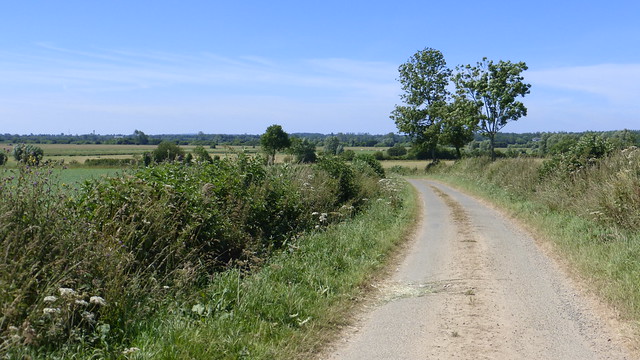
 These trees make up the allée des saules which is a dirt road lined with old willows.
These trees make up the allée des saules which is a dirt road lined with old willows. 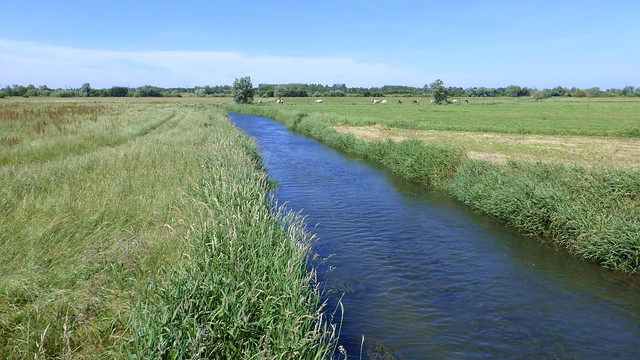
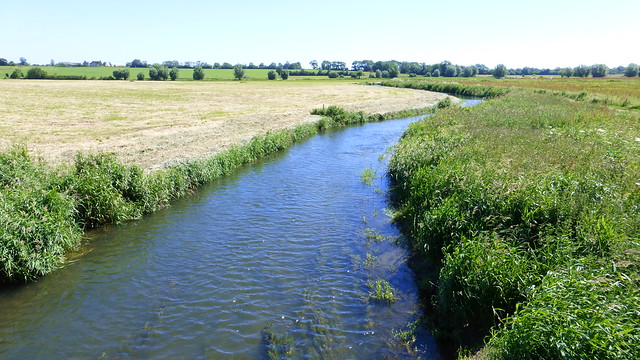 A short distance off the path lays the river Merderet which winds through the countryside.
A short distance off the path lays the river Merderet which winds through the countryside.  The hiking details don't tell you about some of the other things to see in the area. For example, it was by chance that I could see the Manoir de Vauville while hiking--unfortunately, the path does not take you near it.
The hiking details don't tell you about some of the other things to see in the area. For example, it was by chance that I could see the Manoir de Vauville while hiking--unfortunately, the path does not take you near it. 
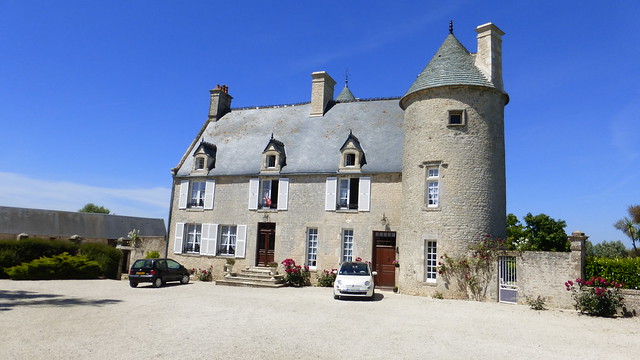
 So I decided to visit using my car. It too is a bed and breakfast catering to people visiting Utah Beach or Sainte-Mère-Église. The hiking tour eventually brings you back into the town. You can find details HERE.
So I decided to visit using my car. It too is a bed and breakfast catering to people visiting Utah Beach or Sainte-Mère-Église. The hiking tour eventually brings you back into the town. You can find details HERE.
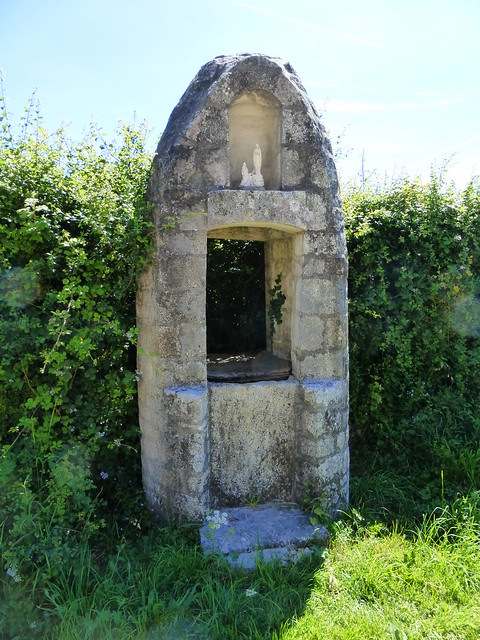


These are just some more photos of the lovely stone houses in and around Fresville. Many of them were adorned with US and French flags--just a way of showing you how much French people respect the sacrifice of the American soldiers who fought in Normandy.
Published by The Baguette
-
in
Cotentin
April 15 2014
2
15
/04
/April
/2014
07:56
Published by The Baguette
-
in
Cotentin





